The Sunshine Coast, located in South-East Queensland, offers a stunning landscape, a welcoming climate and a huge array of bird species. From Woodlands to Montane Forests, beaches, and wetlands, birds can be spotted in every habitat along the Sunshine Coast.
The region serves as a perfect destination for bird watching and photographing, attracting visitors from all over the world.
With over 300 species, including rare and endangered birds, found in the area, Sunshine Coast offers bird enthusiasts, both professional and amateur, a unique opportunity to observe these beautiful creatures in their natural habitat.
This article will provide an insight into the diverse birdlife that can be seen in the Sunshine Coast.
1. Honeyeaters
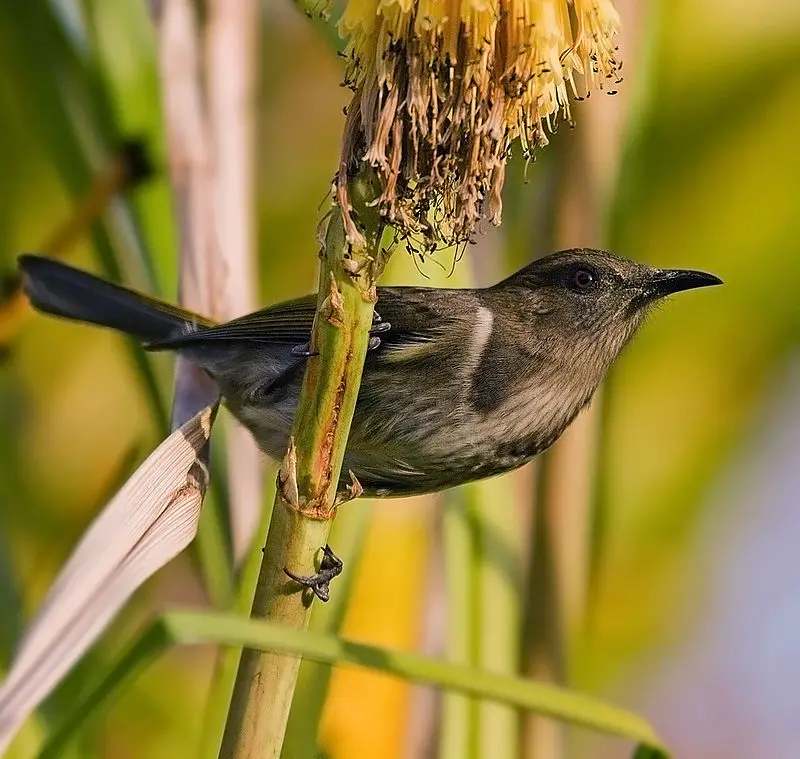
Honeyeaters are a unique and diverse family of birds, with species ranging in size from small to medium.
Found mainly in Australia and New Guinea, they can also be found as far east as Samoa and Tonga, or on islands such as Wallacea north or west of New Guinea.
Honeyeaters feed mainly on nectar but will consume insects if necessary for additional nutrition. They have specialized brush-like tongues that help them extract the nectar efficiently.
Their bright colours tend to make them stand out among other bird families making them easy to spot when out observing wildlife.
Scientific classification:
| Kingdom | Animalia |
| Phylum | Chordata |
| Class | Aves |
| Order | Passeriformes |
| Superfamily | Meliphagoidea |
| Family | Meliphagidae Vigors, 1825 |
Also Featured In: Most common birds in Australia, Guam Birds You Need to See
2. Laughing Kookaburra
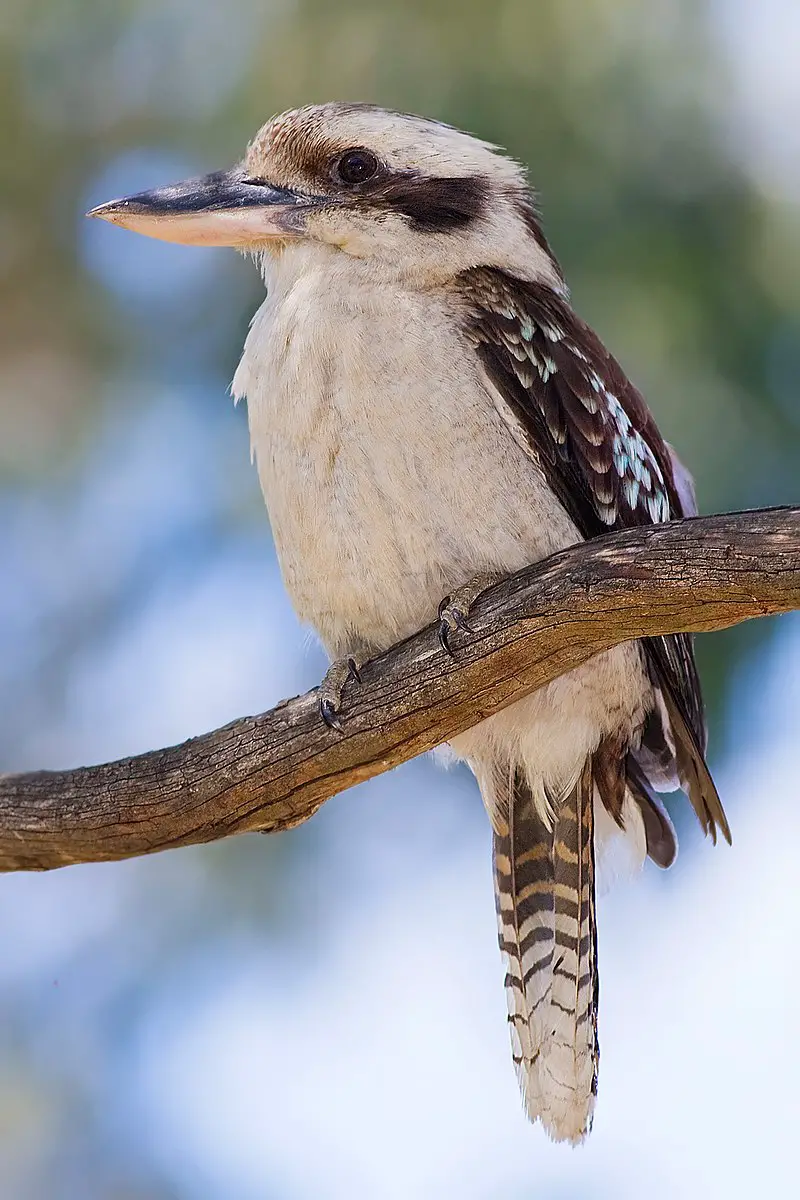
The Laughing Kookaburra is a beautiful bird with distinct features. It has a whitish head and brown eye-stripe, along with an upper body that is predominantly dark brown.
On its wings are mottled light blue patches which make it stand out even more. Its underparts are cream white while its tail is barred in rufous and black colours.
Male and female birds have the same plumage, making them easy to identify as belonging to this species of kingfisher subfamily Halcyoninae.
They can be found living around woodlands or open forests throughout eastern Australia, where they feed on small reptiles, insects or amphibians by swooping down from a perch above them before carrying their prey back up again for consumption.
The sound of their loud distinctive call – “koo-kaa-brrr” – brings joy to many Australians who appreciate these wonderful creatures inhabiting our land
Scientific classification:
| Kingdom | Animalia |
| Phylum | Chordata |
| Class | Aves |
| Order | Coraciiformes |
| Family | Alcedinidae |
| Subfamily | Halcyoninae |
| Genus | Dacelo |
| Species | D. novaeguineae |
Also Featured In: Birds You’ll Find in Zoo, Birds of Tasmania
3. Australian King Parrot
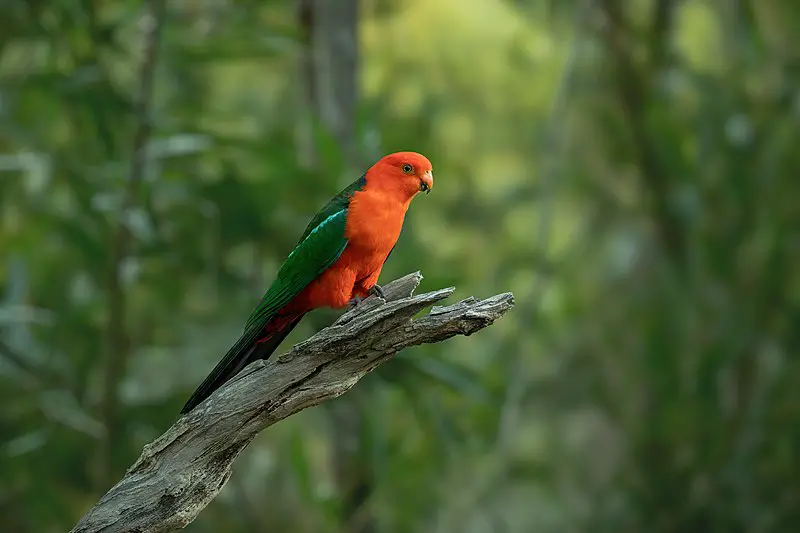
The Australian king parrot is a colourful bird endemic to eastern Australia. It lives in humid, heavily forested areas of the continent including eucalyptus woodlands and subtropical and temperate rainforest.
The King Parrot has an unmistakable green back with red underparts for males, females show more muted colours but still have a bright red belly.
These birds feed on fruits and seeds gathered from trees or shrubs such as Eucalyptus, Acacia or Lillipilli.
They are also commonly seen scavenging for food near roadsides where people often leave scraps behind – so it pays to be careful if you’re driving through any areas they inhabit.
Despite their small size these birds are quite vocal making them easily noticed by both humans and other wildlife alike.
Scientific classification:
| Kingdom | Animalia |
| Phylum | Chordata |
| Class | Aves |
| Order | Psittaciformes |
| Family | Psittaculidae |
| Genus | Alisterus |
| Species | A. scapularis |
4. Black Swan
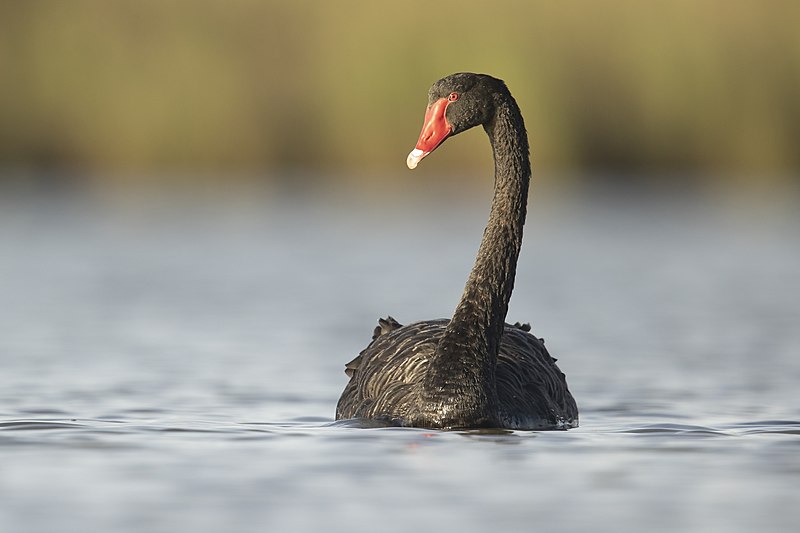
The Black Swan is a beautiful species of swan found in many parts of Australia. It has black plumage and a bright red bill, making it quite distinctive from other birds in the region.
These majestic birds are monogamous and both parents take turns incubating eggs as well as raising cygnets together.
They have an erratic migration pattern that depends on climatic conditions, although they usually move within their native range to find suitable habitats for breeding and feeding purposes.
The Black Swan’s graceful presence adds beauty to any water body they inhabit while also serving as important indicators of environmental health due to their sensitivity towards changes in their habitat quality.
Scientific classification:
| Kingdom | Animalia |
| Phylum | Chordata |
| Class | Aves |
| Order | Anseriformes |
| Family | Anatidae |
| Genus | Cygnus |
| Species | C. atratus |
Also Featured In: Small Birds that Live in New South Wales, Black Birds in New Zealand
5. Pheasant Coucal
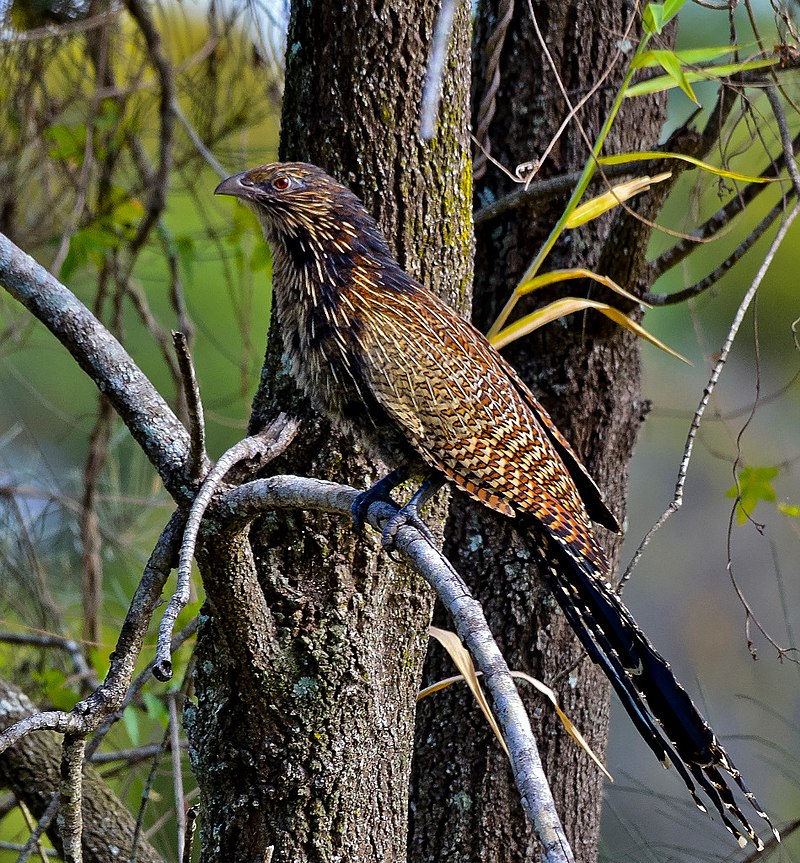
The Pheasant Coucal is a species of cuckoo native to Australia, Timor and New Guinea.
It can be found in subtropical or tropical moist lowland forests as well as mangrove forests but has also adapted well to agricultural areas such as cane fields in Northern Australia.
This makes it an unusual bird among the Australian cuckoos since unlike most other birds from this family, it doesn’t rely on its hosts for incubation and raising offsprings – instead, it does all that by itself.
The female typically lays three eggs which are oval-shaped with light blue colouring that fades over time.
Pheasant coucals have dark brown feathers with some lighter markings around their necks and wings making them look quite unique compared to other birds within the same family.
Scientific classification:
| Kingdom | Animalia |
| Phylum | Chordata |
| Class | Aves |
| Order | Cuculiformes |
| Family | Cuculidae |
| Genus | Centropus |
| Species | C. phasianinus |
6. Rose-Crowned Fruit Dove
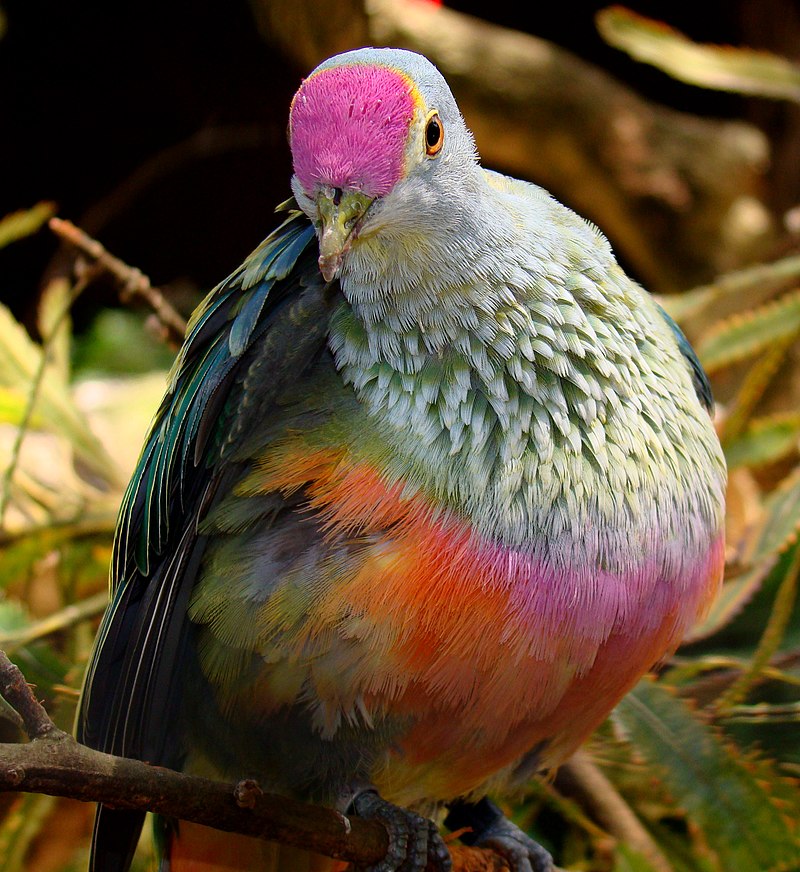
The Rose-crowned Fruit Dove is a beautiful and vibrant bird found mainly in the forests of Australia, New Guinea and some parts of Indonesia.
It has an unmistakable appearance due to its grey head and breast, orange belly, whitish throat and yellow-orange iris.
The crown on its head is pinkish-red with a yellow border which sets it apart from other fruit doves. This species can grow up to 22 cm long and have greyish green bills as well as feet.
In Indonesian subspecies however have white crowns instead of red ones.
They are generally found in small groups feeding on fruits or berries near trees or shrubs but they may also be seen alone occasionally when searching for food during the day time
Scientific classification:
| Kingdom | Animalia |
| Phylum | Chordata |
| Class | Aves |
| Order | Columbiformes |
| Family | Columbidae |
| Genus | Ptilinopus |
| Species | P. regina |
7. Magpie Goose
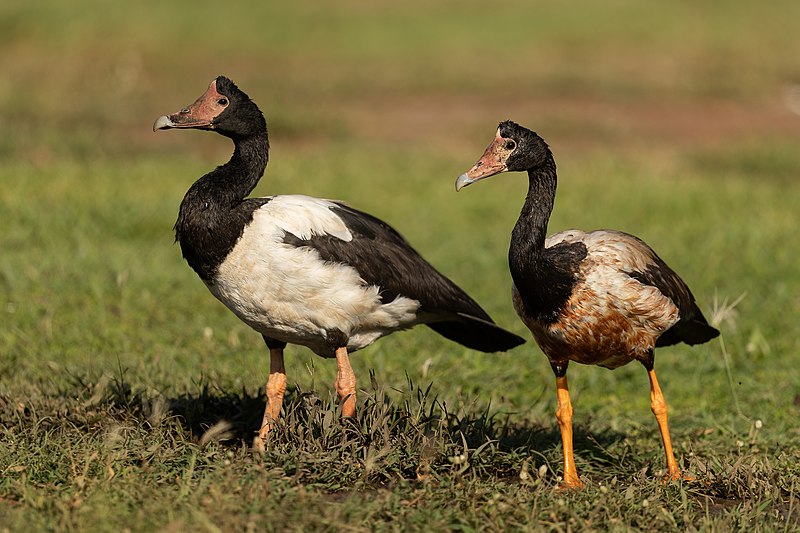
The Magpie Goose is a unique waterbird native to northern Australia and southern New Guinea. It can sometimes be found outside its range due to wandering, but was once widespread in southern Australia until it disappeared.
This species has a distinctive black-and-white plumage with an orange bill and feet which makes them easily recognisable amongst other birds.
They usually live in small flocks around wetlands where they feed on aquatic plants and insects, as well as grain crops when available.
The magpie goose nests near the ground or atop tall vegetation such as reeds or shrubs, laying eggs that are incubated by both parents for up to 30 days before hatching into fluffy yellow goslings.
These beautiful geese have adapted over time so they can survive even during dry periods of their habitats making them an integral part of many wetland ecosystems across Northern Australia and Southern New Guinea
Scientific classification:
| Kingdom | Animalia |
| Phylum | Chordata |
| Class | Aves |
| Order | Anseriformes |
| Family | Anseranatidae |
| Genus | Anseranas Lesson, 1828 |
| Species | A. semipalmata |
Also Featured In: Papua New Guinea birds,
8. Varied Triller
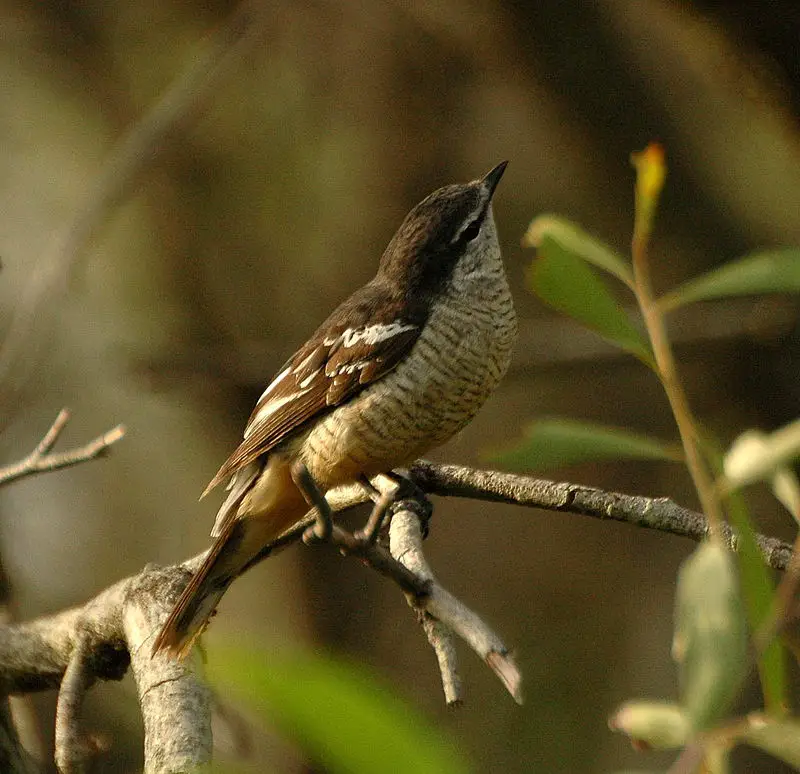
The varied triller is a small, colorful bird belonging to the cuckoo-shrike family. Native to New Guinea and the Bismarck Archipelago as well as parts of eastern Australia, this species prefers warm, fairly moist climates.
It has an unmistakable plumage that includes white wings with black barring and bright yellow underparts.
The head is grayish-brown while its tail feathers are largely brown but tipped in white.
Its call consists of a series of short whistles which it uses both for communication among flock members and territorial defense against other birds or predators in the area.
Although not widely known compared to some other avian species, these delightful birds can be seen flitting about their natural habitats if one knows where to look.
Scientific classification:
| Kingdom | Animalia |
| Phylum | Chordata |
| Class | Aves |
| Order | Passeriformes |
| Family | Campephagidae |
| Genus | Lalage |
| Species | L. leucomela |
9. Noisy Friarbird
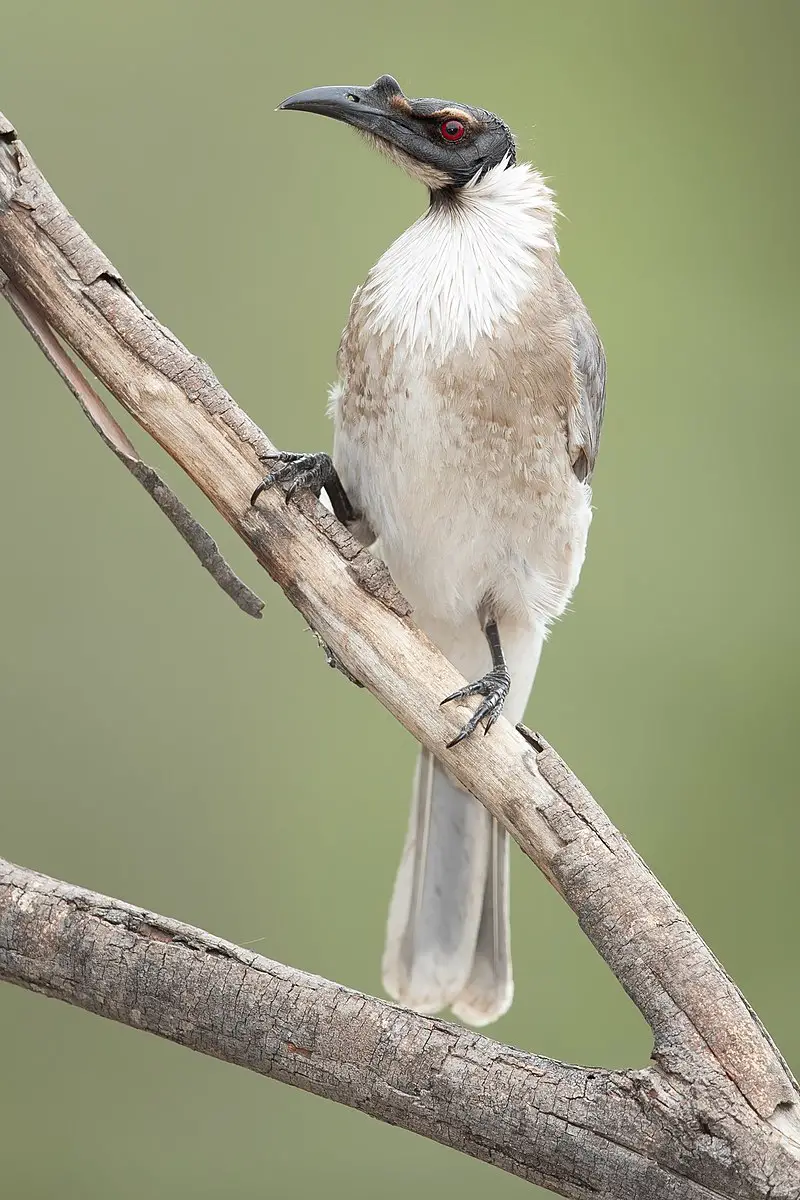
The Noisy Friarbird is a native of Southern New Guinea and Eastern Australia. It’s easily recognisable due to its brown-grey colouration, as well as the prominent knob on its head which is bare black skinned.
This bird belongs to the honeyeater family Meliphagidae, making it one of several species referred to as friarbirds with their featherless heads.
The diet for this particular species consists mainly of insects such as bees and ants, but also nectar from flowers when in season.
First described by ornithologist John Latham in 1802, they are commonly found near woodlands close to water sources like rivers or streams where there is plenty of food available during breeding season which usually occurs between August and December each year.
Scientific classification:
| Kingdom | Animalia |
| Phylum | Chordata |
| Class | Aves |
| Order | Passeriformes |
| Family | Meliphagidae |
| Genus | Philemon |
| Species | P. corniculatus |
10. Oriental Cuckoo
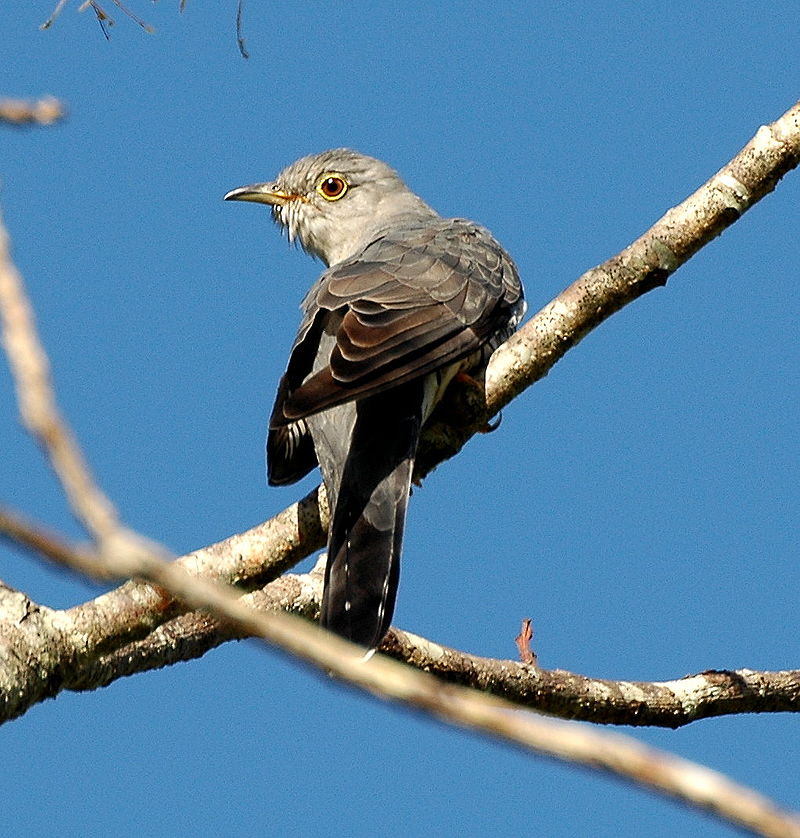
The Oriental Cuckoo, also known as Horsfields cuckoo, is a species of bird in the family Cuculidae. It was formerly classified as a subspecies of Himalayan cuckoo but its differences in voice and size made it worthy to be treated separately.
This medium-sized songbird has brown upperparts with white spots and rufous underparts with dark barring.
The wings are barred blackish-brown on their outer webs while the tail feathers have broad bars at their tips forming two white bands across them.
Although they breed mainly where conifers grow, these birds can often be seen flitting through deciduous forest edges or woodlands during migration season when they fly south from northern Asia to spend winter in Southeast Asia.
They feed mostly on caterpillars and other insects which makes them important pest controllers for our environment.
Scientific classification:
| Kingdom | Animalia |
| Phylum | Chordata |
| Class | Aves |
| Order | Cuculiformes |
| Family | Cuculidae |
| Genus | Cuculus |
| Species | C. optatus |
Also Featured In: Timor-Leste birds, Birds Commonly Found in Kyoto
11. Dusky Moorhen
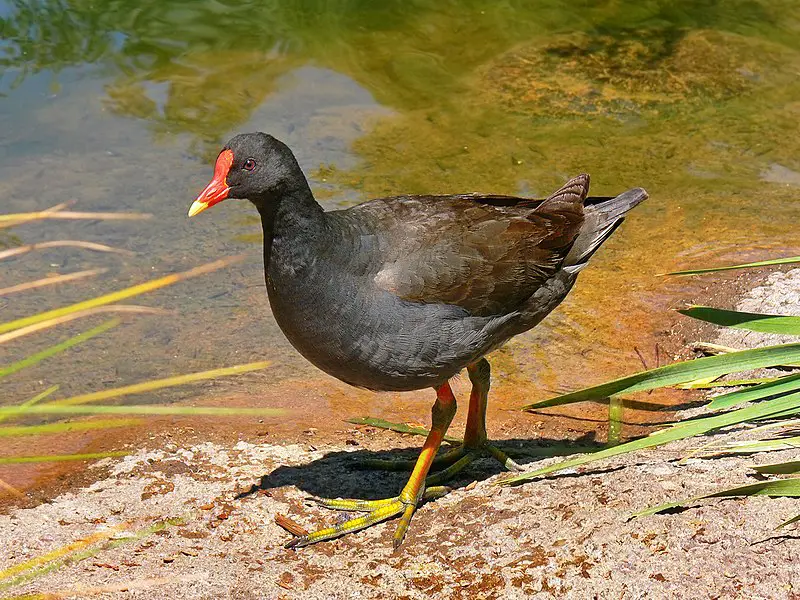
The dusky moorhen is a species of bird found in India, Australia, New Guinea, Borneo and Indonesia. It has dark plumage with an iridescent green sheen on its back and wings.
Its beak and legs are yellow-orange in color. The tail is long and pointed. Dusky moorhens live around freshwater wetlands such as swamps or ponds where they feed largely on aquatic vegetation but may also eat small insects or fish if available.
They often live alongside other birds from the same genus like purple swamphens or Eurasian coots which have similar appearances but different habitats preferences than their own species’.
Although timid when approached by humans these birds still make fascinating subjects for observation due to their unique behaviors within family groups that can help us understand more about them.
Scientific classification:
| Kingdom | Animalia |
| Phylum | Chordata |
| Class | Aves |
| Order | Gruiformes |
| Family | Rallidae |
| Genus | Gallinula |
| Species | G. tenebrosa |
Also Featured In: Birds that Live Near Adelaide,
12. Intermediate Egret
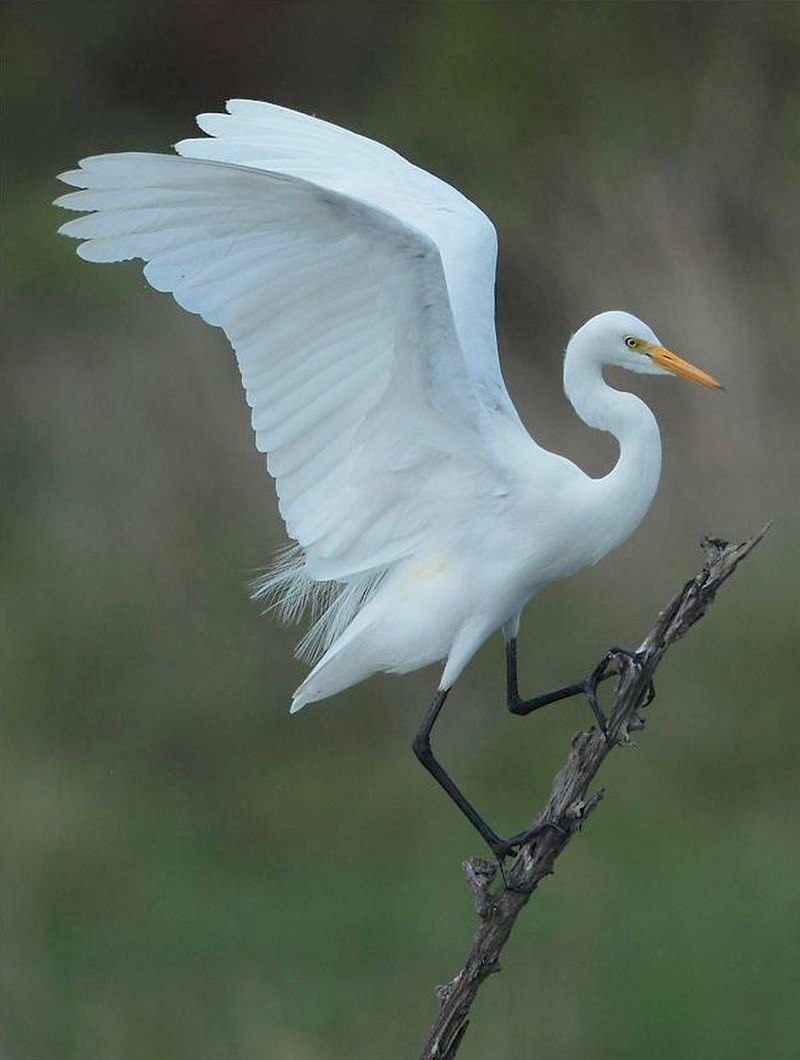
The Intermediate Egret is a medium-sized heron native to East Africa, the Indian subcontinent, Southeast Asia and Australia. It has yellow bill with black tip, chestnut legs and feet.
Its plumage varies from white in breeding season to greyish or brownish non-breeding season. It feeds on small fish, insects and frogs near freshwater habitats such as lakes, marshes and ponds.
They are commonly seen perched atop tall trees where they hunt for prey during low tides at estuarine areas like mudflats or mangroves swamps.
During nesting time they build nests of sticks high up in trees which can be reused year after year if left undisturbed by humans or predators.
The Intermediate Egret is an adaptable bird that offers great potentials for conservation efforts due its wide range across different continents.
Scientific classification:
| Kingdom | Animalia |
| Phylum | Chordata |
| Class | Aves |
| Order | Pelecaniformes |
| Family | Ardeidae |
| Genus | Ardea |
| Species | A. intermedia |
Also Featured In: Mauritius birds, Birds that Commonly Found in Pond
13. Rufous Fantail
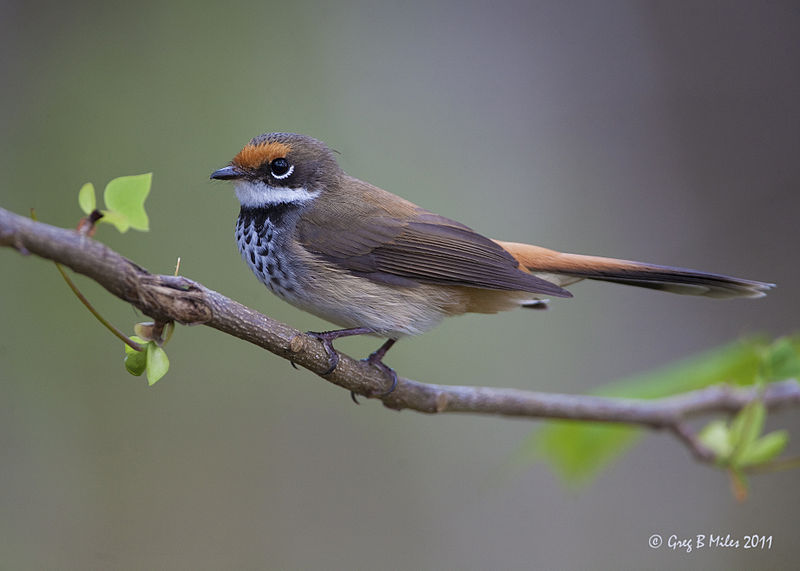
The Rufous Fantail is a small passerine bird found in Australia, Indonesia, Micronesia, New Guinea and the Solomon Islands.
It inhabits rainforests, wet forests, swamp woodlands and mangroves which makes it quite adaptable.
These birds are usually black-breasted with distinctive rufous wings and tail feathers that they use to fan out while looking for food on branches or shrubs.
They also often flick their tails from side to side as they search for insects like flies or moths.
The call of the Rufous Fantail consists of a series of high pitched notes that can be heard during its breeding season from September through February when mating pairs sing together near nesting sites such as tree hollows or rock crevices.
Despite their relatively small size these birds make an impressive presence thanks to their bold colors displayed in flight making them easy to spot even at great distances.
Scientific classification:
| Kingdom | Animalia |
| Phylum | Chordata |
| Class | Aves |
| Order | Passeriformes |
| Family | Rhipiduridae |
| Genus | Rhipidura |
| Species | R. rufifrons |
Also Featured In: Solomon Islands birds,
14. White-Breasted Woodswallow
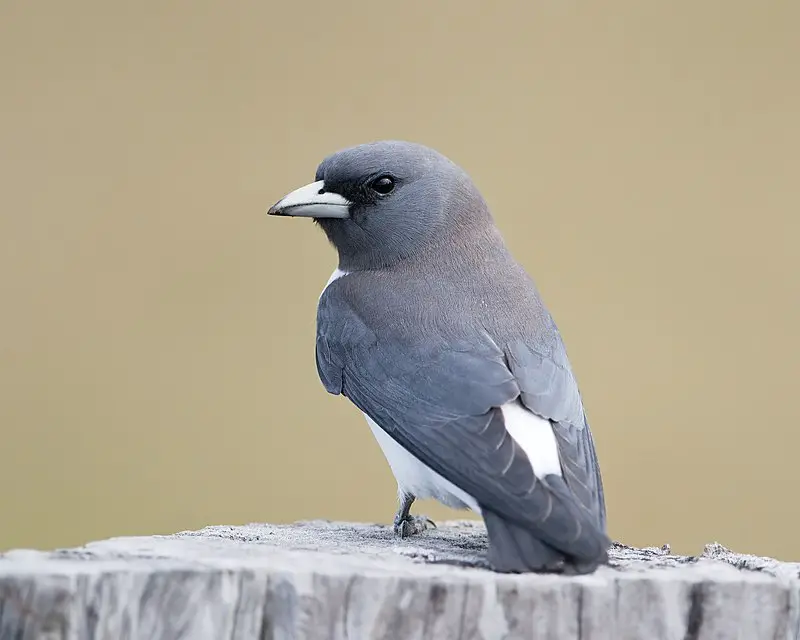
The White-breasted Woodswallow is a medium-sized passerine bird found in the Andaman Islands, Indonesia and Northern Australia.
Its name may be misleading as it does not belong to the family of true swallows but rather belongs to Artamidae which also includes butcherbirds, currawongs and Australian magpie.
These birds are mainly greyish brown with white belly patch and long wings having two pale bars on them.
They feed on insects like ants, beetles etc., captured from foliage or air during flight.
Breeding season for this species starts from October till December when they build their cup shaped nests out of twigs near tree trunks or branches usually high up in trees for protection against predators such as snakes or raptors.
Male woodswallows can often been seen singing loudly while displaying its aerial maneuvering capabilities trying to attract potential mates.
Scientific classification:
| Kingdom | Animalia |
| Phylum | Chordata |
| Class | Aves |
| Order | Passeriformes |
| Family | Artamidae |
| Genus | Artamus |
| Species | A. leucorynchus |
Also Featured In: Brunei birds,
15. Common Cicadabird
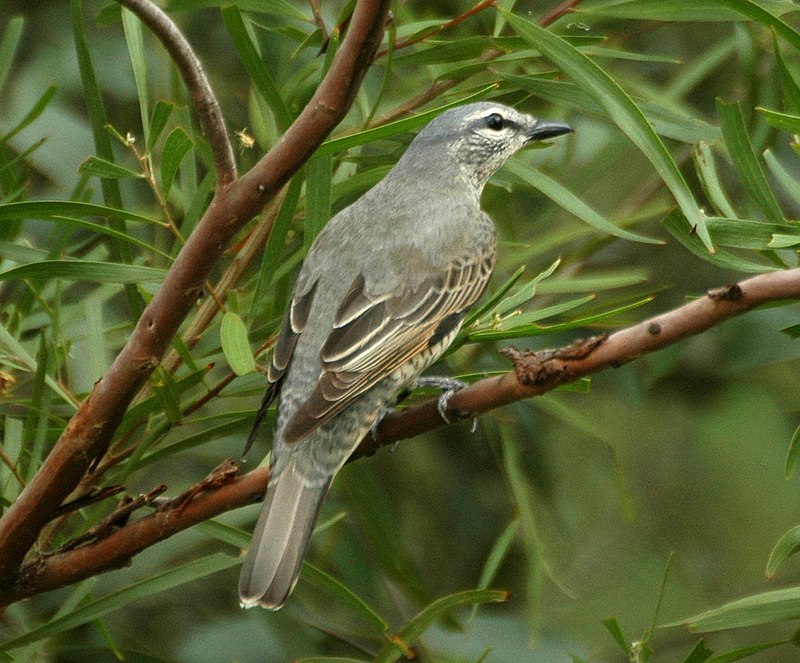
The Common Cicadabird is a species of bird found in Australia, Indonesia, New Guinea and the Solomon Islands. It typically inhabits temperate forest or subtropical moist lowland forests.
This slender-billed bird has olive green upperparts with white streaking on its back and wings and yellow under parts with some dark barring on its breast.
Its song consists of loud cicada like calls that can be heard from up to several hundred meters away.
The common cicadabird feeds primarily on insects such as caterpillars, grasshoppers and beetles which it catches by sallying out from an exposed perch before returning to the same spot once again.
Overall this small passerine makes for an interesting addition to any local wildlife area.
Scientific classification:
| Kingdom | Animalia |
| Phylum | Chordata |
| Class | Aves |
| Order | Passeriformes |
| Family | Campephagidae |
| Genus | Edolisoma |
| Species | E. tenuirostre |
Also Featured In: Palau birds,
16. Wandering Tattler
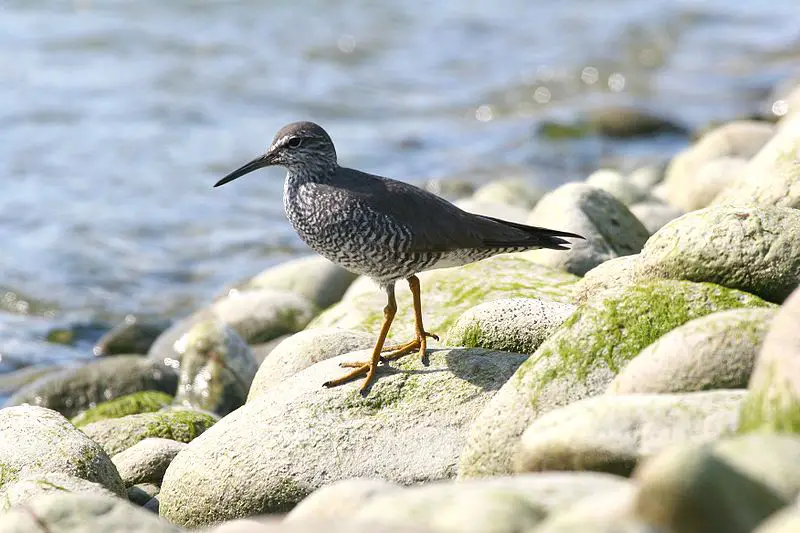
The Wandering Tattler is a medium-sized wading bird found in coastal areas throughout the world. It has unpatterned, greyish wings and back, as well as a scaly breast pattern that extends onto its belly.
Its closest relative is the Gray-tailed Tattler (Tringa brevipes). The species feeds on insects and crustaceans which they hunt along shorelines. They also take advantage of low tide to feed on exposed mudflats or sandbars.
During migration season these birds can be seen flying long distances over open ocean waters with their characteristic fluttering flight pattern before reaching land again to rest and refuel for another journey ahead.
Scientific classification:
| Kingdom | Animalia |
| Phylum | Chordata |
| Class | Aves |
| Order | Charadriiformes |
| Family | Scolopacidae |
| Genus | Tringa |
| Species | T. incana |
Also Featured In: Cook Islands birds, Hawaii Big Island Birds You Should Know
17. Yellow-Tailed Black Cockatoo
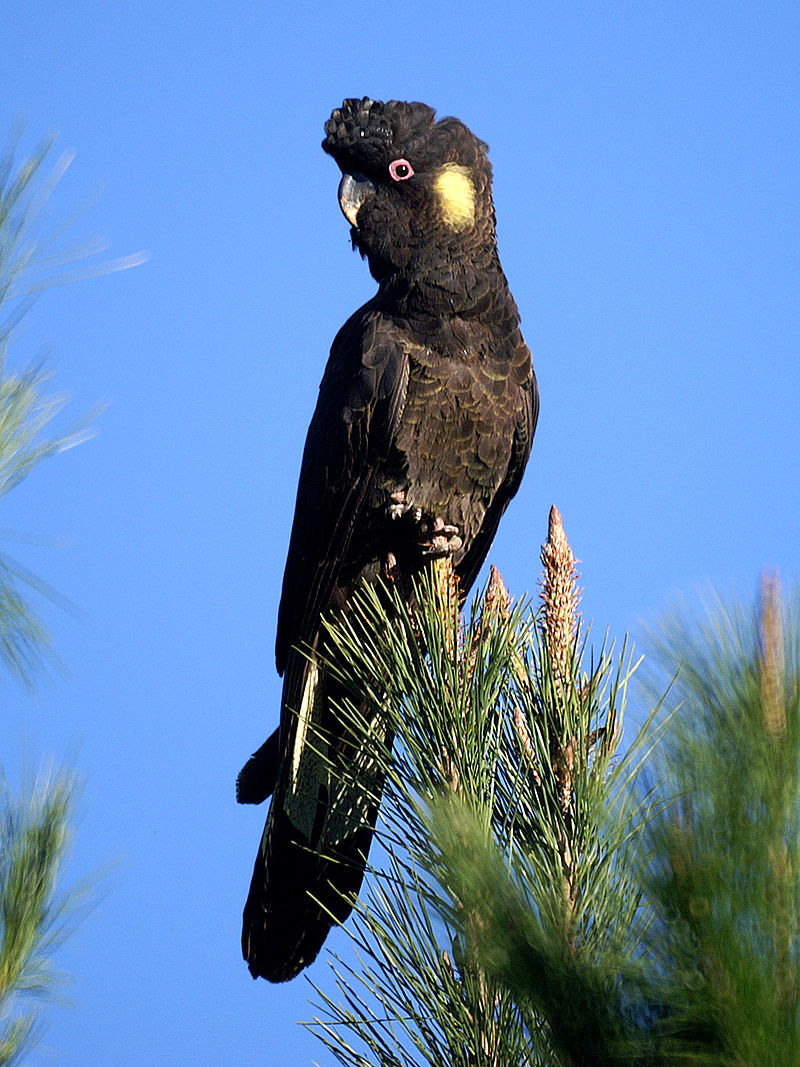
The Yellow-tailed Black Cockatoo is a beautiful bird native to Australia. It measures 55–65 cm in length and has an unmistakable look with its brownish black plumage, yellow cheek patches, short crest on the top of its head and prominent yellow tail band.
The feathers are also edged with yellow giving it a unique scalloped appearance. Males have a striking black beak while females have pink beaks with grey tips – making them easy to tell apart at first glance.
They prefer woodlands but can sometimes also be seen near urban areas as well as open grassy woodlands or forests where they feed on seeds from eucalypts, acacias and banksias among other plants.
They make loud screeching noises when flying which makes them easily identifiable even from afar.
Scientific classification:
| Kingdom | Animalia |
| Phylum | Chordata |
| Class | Aves |
| Order | Psittaciformes |
| Family | Cacatuidae |
| Genus | Zanda |
| Species | Z. funerea |
Also Featured In: Parrots Species, Birds that Live around Brisbane
18. Australasian Gannet
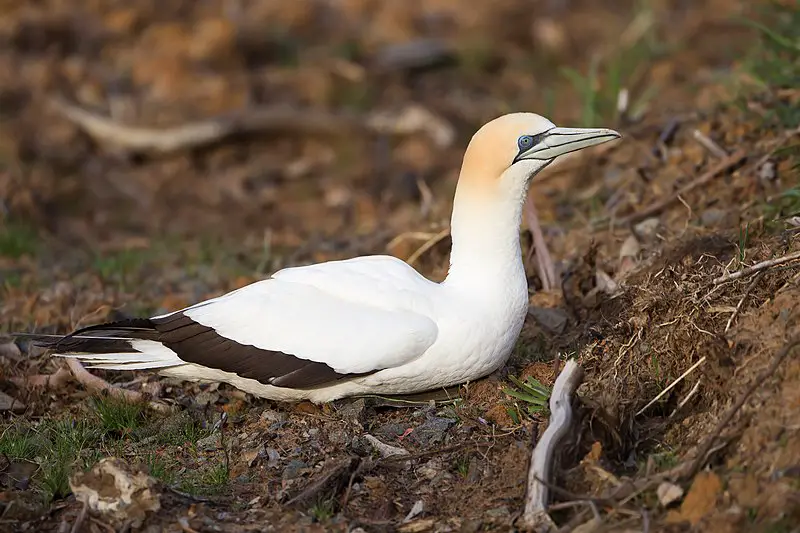
The Australasian gannet is a beautiful seabird with white feathers and black flight feathers that line its wings. Its head has a buff-yellow hue, with blue-grey bill edged in black and bright blue eyes.
It belongs to the booby and gannet family of Sulidae birds. This bird can be found off the coasts of Australia and New Zealand as well as other nearby islands including Lord Howe Island, Norfolk Island, Kangaroo Island, Tasmania South Australia’s Fleurieu Peninsula etc.
As they are excellent swimmers they feed on fish at sea by plunging into water from great heights or near surface swimming along shoals of small fishes in shallow waters.
The name “gannet” comes from an old English word for “gans” meaning goose-like bird because it looks like one when flying high above the ocean but dives down gracefully while hunting fish underwater.
Scientific classification:
| Kingdom | Animalia |
| Phylum | Chordata |
| Class | Aves |
| Order | Suliformes |
| Family | Sulidae |
| Genus | Morus |
| Species | M. serrator |
Also Featured In: Booby Species, Birds that Live in the Ocean
19. Variegated Fairywren
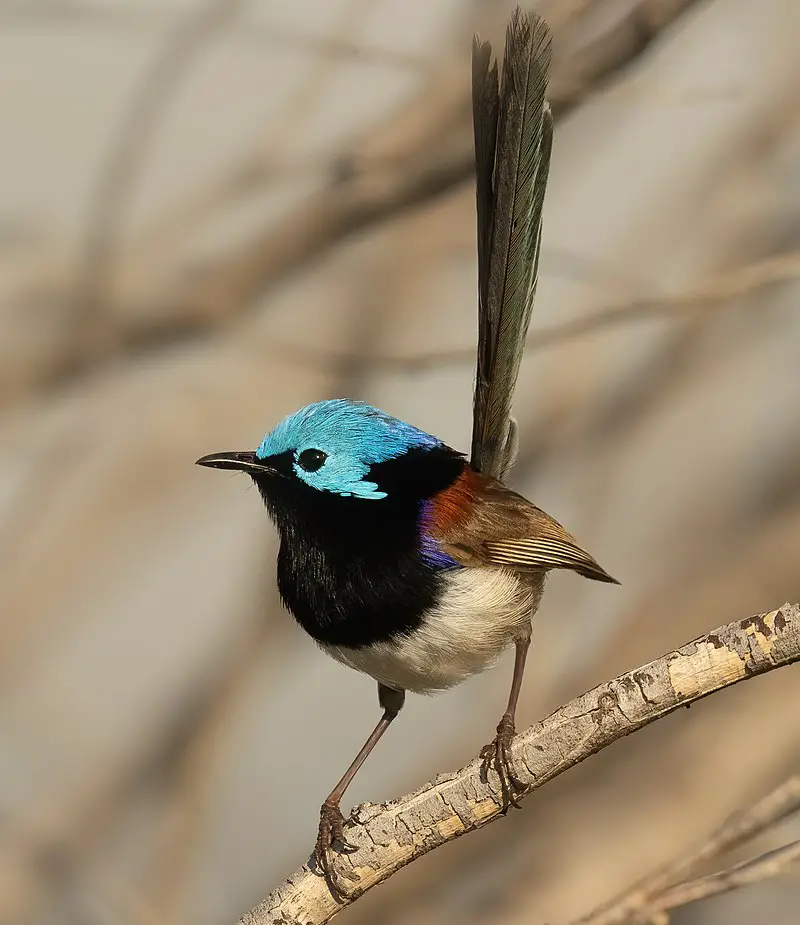
The Variegated Fairywren is a beautiful bird native to eastern Australia. It has distinctive sexual dimorphism, with males being brightly coloured during breeding season while non-breeding males, females and juveniles have grey-brown plumage.
Females of two subspecies are mostly blue-grey in colouration. They inhabit shrubs and bushes near streams or other water sources for their food which predominantly consists of invertebrates such as insects and worms.
These birds also feed on seeds from grasses, sedges and herbs when available in the area they live in.
The nests of these fairywrens are usually built close to ground level within dense vegetation where they can be safe from predators like snakes or cats that could potentially harm them or even snatch away its eggs before hatching occurs.
Scientific classification:
| Kingdom | Animalia |
| Phylum | Chordata |
| Class | Aves |
| Order | Passeriformes |
| Family | Maluridae |
| Genus | Malurus |
| Species | M. lamberti |
Also Featured In: Wrens Species, Birds that Live in Gold Coasts
20. Wompoo Fruit Dove
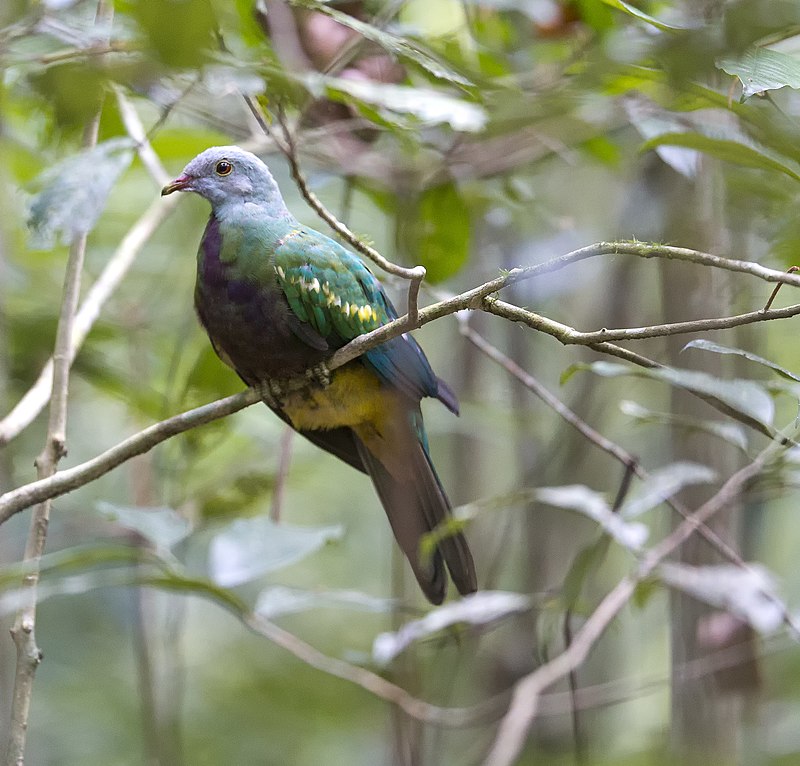
The Wompoo Fruit Dove is a beautiful bird native to New Guinea and eastern Australia. It has an impressive wingspan of up to 45 cm, although they tend to be much smaller in the northern regions.
The dove’s plumage varies from purple around its neck, chest and upper belly, with greyish-brown feathers covering the rest of its body.
This species lives mainly on fruit but will occasionally feed on insects for extra protein and nutrition.
They can also often be seen sipping nectar from flowers or drinking water off leaves in humid rainforest environments.
Although these birds are not currently threatened by extinction, their numbers have decreased due to deforestation of their natural habitats as well as hunting pressure from humans living near them.
Fortunately however conservation efforts are being made across many areas which may help ensure that this lovely species survives into future generations.
Scientific classification:
| Kingdom | Animalia |
| Phylum | Chordata |
| Class | Aves |
| Order | Columbiformes |
| Family | Columbidae |
| Genus | Ptilinopus |
| Species | P. magnificus |
Also Featured In: birds of purple, Birds Typically Found in Australian Rainforest
21. Olive-Backed Oriole
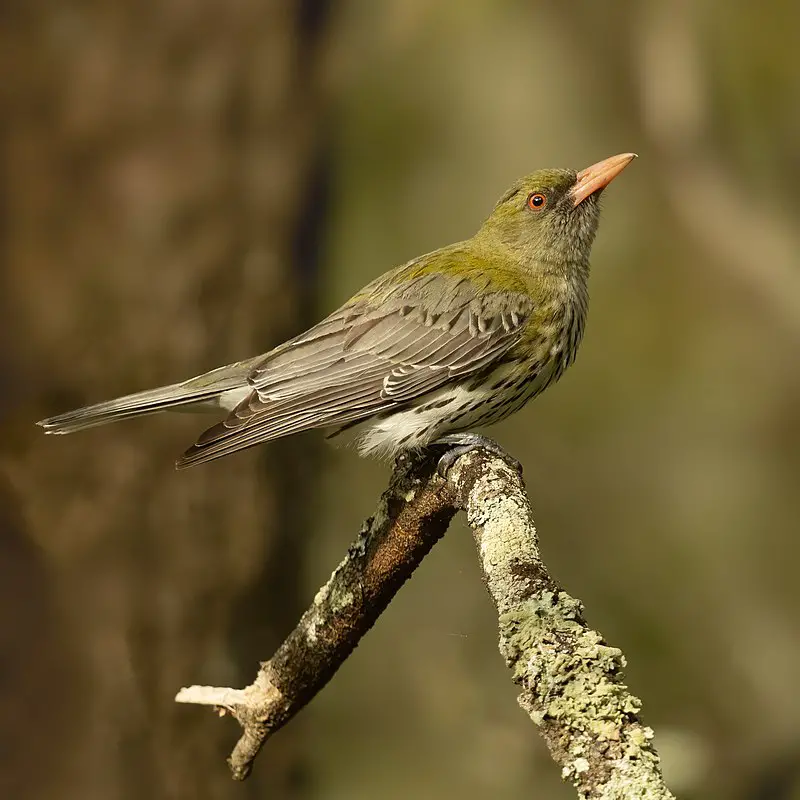
The olive-backed oriole is a medium-sized bird found in northern and eastern Australia and south-central New Guinea. It is known for its noisy and conspicuous behavior, making it easy to spot.
This bird was first described by John Latham in 1801, and is the most widespread Australasian oriole. With its distinctive white belly, this bird is a common sight among trees and bushes.
The olive-backed oriole belongs to the Coracias genus and has four sub-species.
It is a passerine bird that is often vocal, producing a range of calls and songs. If you’re ever in northern or eastern Australia or south-central New Guinea, keep an eye out for the olive-backed oriole and its beautiful plumage.
Scientific classification:
| Kingdom | Animalia |
| Phylum | Chordata |
| Class | Aves |
| Order | Passeriformes |
| Family | Oriolidae |
| Genus | Oriolus |
| Species | O. sagittatus |
Also Featured In: Birds that Charles Darwin Studied, Common Townsville Birds
22. Striated Pardalote
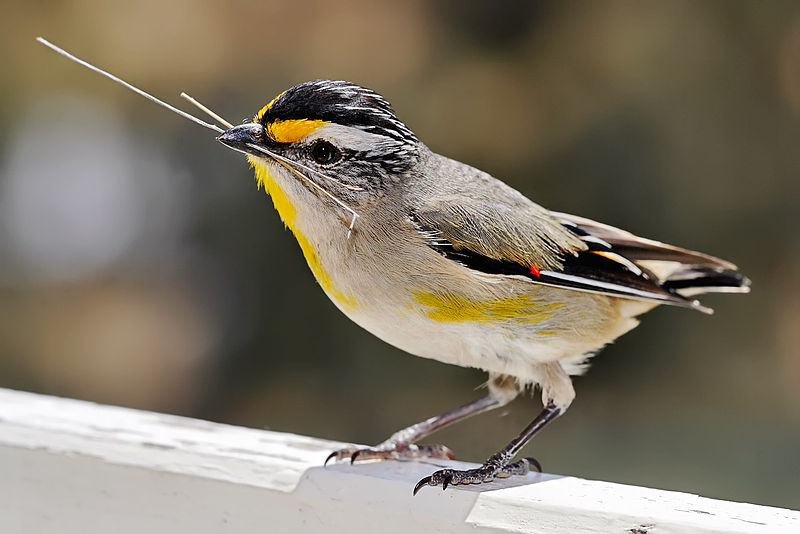
The Striated pardalote, also known as pickwick, wittachew or chip-chip, is a small, short-tailed bird. It is the most common and least colorful of the four pardalote species, and is frequently heard foraging in treetops for small creatures like lerps.
The Striated pardalote is more often heard than seen due to its inconspicuous appearance. Four distinct species of the pardalote were initially identified, but the Striated pardalote can be recognized by its physical characteristics.
Despite its lack of dazzling colors, this bird is a beloved sight for birdwatchers, and contributes to the biodiversity of the local ecosystem.
Scientific classification:
| Kingdom | Animalia |
| Phylum | Chordata |
| Class | Aves |
| Order | Passeriformes |
| Family | Pardalotidae |
| Genus | Pardalotus |
| Species | P. striatus |
Also Featured In: Birds that Live in Kangaroo Island,
23. Pied Butcherbird
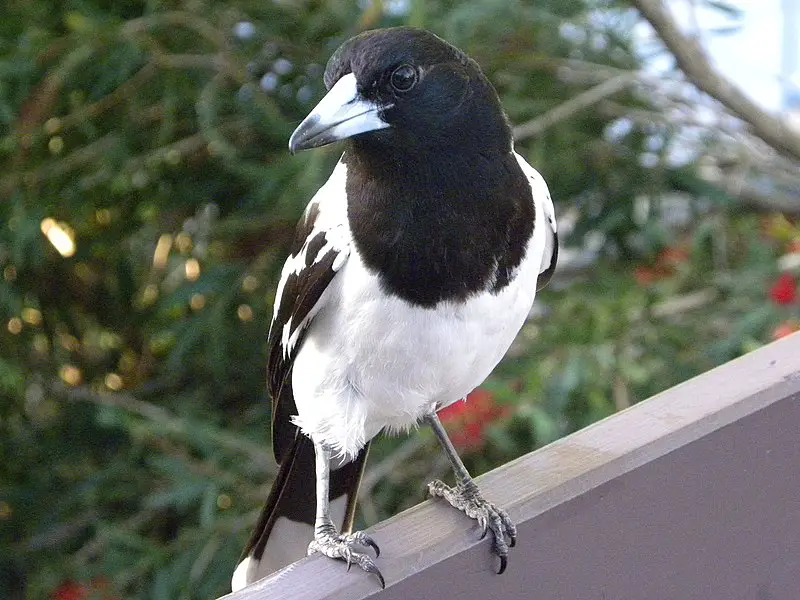
The Pied Butcherbird is a native Australian songbird that measures around 28 to 32 cm in length.
Its striking black and white plumage includes a black hood around its head and throat, as well as black tail and wings, while its neck, outer wings, and underparts are white.
Its long, hook-shaped bill is used for catching prey, usually insects or small mammals. This bird was first described by John Gould in 1837.
The Pied Butcherbird is known for its beautiful, melodious song, often performed in groups or pairs.
The species is common in woodlands and forests across much of Australia, and has successfully adapted to urban and suburban environments.
The juveniles have a more subdued plumage compared to the adults, with a brownish-grey coloration replacing the black feathers.
Scientific classification:
| Kingdom | Animalia |
| Phylum | Chordata |
| Class | Aves |
| Order | Passeriformes |
| Family | Artamidae |
| Genus | Cracticus |
| Species | C. nigrogularis |
24. Pale-Headed Rosella
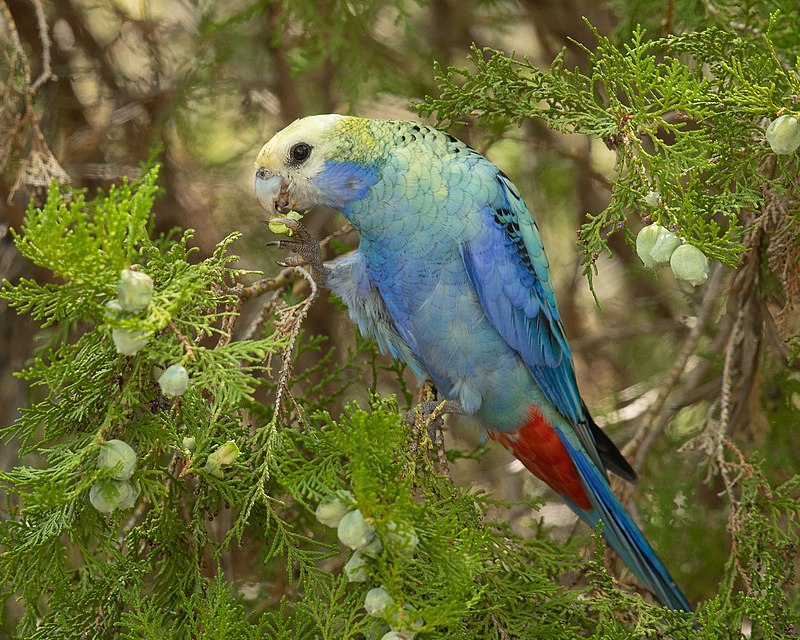
The Pale-headed rosella is a beautiful parrot found in northeastern Australia. This bird is a moderate-size parrot with a mostly pale yellow head, white cheeks, and blue underparts.
Its back is scalloped with black and gold, making it a stunning sight. While some experts consider it to be the same as the eastern rosella, two subspecies of the Pale-headed rosella are recognized.
These birds are known for their intelligence and are popular among bird lovers. They make excellent pets due to their affectionate nature, and with proper care, can live for up to 20 years.
In the wild, they feed on seeds, fruits, and insects, and can be found in open woodlands, forest edges, and urban areas.
Overall, the Pale-headed rosella is a delightful and fascinating bird to observe and interact with.
Scientific classification:
| Kingdom | Animalia |
| Phylum | Chordata |
| Class | Aves |
| Order | Psittaciformes |
| Family | Psittaculidae |
| Genus | Platycercus |
| Species | P. adscitus |
Also Featured In: Queensland Birds You Should Know,
25. Scarlet Myzomela
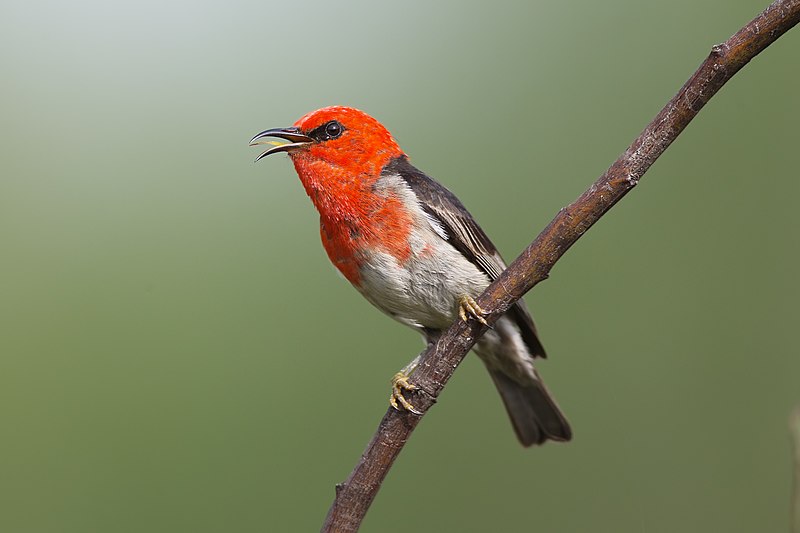
The Scarlet myzomela, also known as the Scarlet honeyeater, is a tiny bird from Australia belonging to the honeyeater family. It was identified by John Latham, an ornithologist from England in 1801.
With a length of only 9 to 11 centimeters, it is the smallest honeyeater bird in Australia featuring a short tail and a long, down-curved beak.
The male and female Scarlet myzomelas have a noticeable difference with respect to their gender.
The male Scarlet myzomela has a vibrant scarlet coloration while female birds have olive-green feathers. Scarlet myzomela birds often feed on the nectar of flowers while hovering in the air.
These birds are seen to feed on plants such as eucalyptus, grevillea, and paperbark among others.
Scarlet myzomelas are little creatures that add vibrancy to the colorful wildlife of Australia.
Scientific classification:
| Kingdom | Animalia |
| Phylum | Chordata |
| Class | Aves |
| Order | Passeriformes |
| Family | Meliphagidae |
| Genus | Myzomela |
| Species | M. sanguinolenta |
Also Featured In: Native Birds Of Mackay,
26. Bar-Shouldered Dove
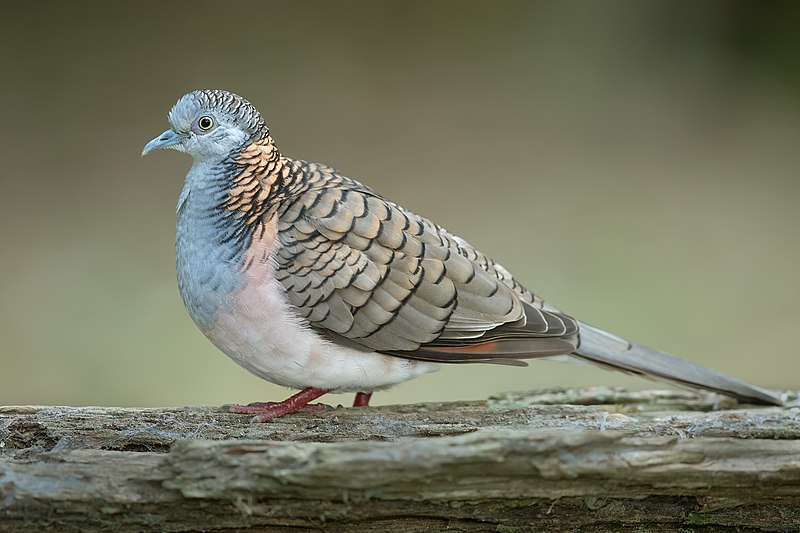
The Bar-shouldered dove, also known as Geopelia humeralis, is a medium-sized pigeon species that can be found in Australia and Southern New Guinea. This bird is protected by the National Parks and Wildlife Act of 1974.
It has a unique and pleasing voice that sounds like “cook-a-wook” or “coolicoo.” Additionally, the Bar-shouldered dove has blue-grey breast feathers and chequered brown-bronze wings. It is quite striking to look at and is known for its long, elegant tail.
This bird is a fascinating species with a lot of fun facts to explore.
Scientific classification:
| Kingdom | Animalia |
| Phylum | Chordata |
| Class | Aves |
| Order | Columbiformes |
| Family | Columbidae |
| Genus | Geopelia |
| Species | G. humeralis |
Also Featured In: New South Wales Birds You Need to See,
27. Peaceful Dove
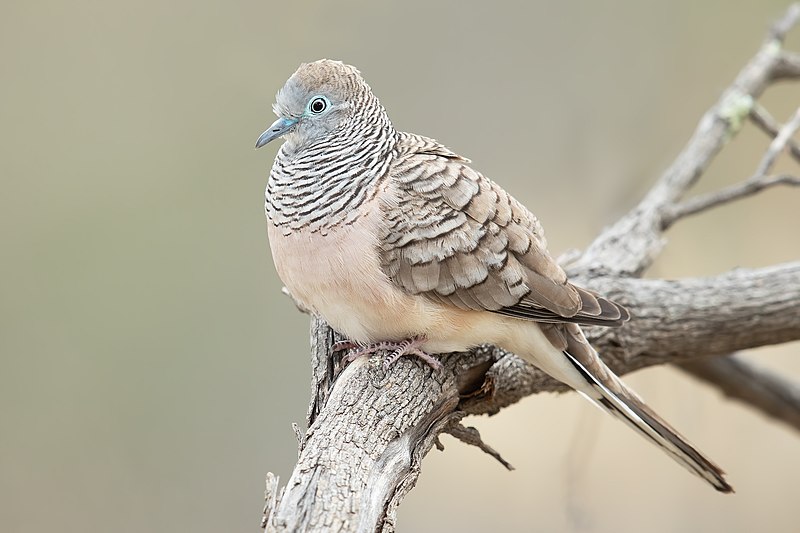
The Peaceful dove is a native bird of Australia and Papua New Guinea. It is a petite pigeon, ranging in size from 19 to 21 centimeters.
This bird belongs to the Geopelia family and is closely related to the Zebra dove of southeast Asia and the Barred dove of eastern Indonesia.
Although until recently, all three species were classified as a single species – Geopelia Striata. The peaceful dove, also known as the Zebra dove, is a peaceful bird with a gentle nature.
Due to their docile temperament, they are often kept as pets. Despite their small size, they are able to fly quickly and gracefully.
The colorful appearance of their feathers, mixed with their pleasant cooing sound, makes the Peaceful dove an enjoyable sight for bird watchers.
Scientific classification:
| Kingdom | Animalia |
| Phylum | Chordata |
| Class | Aves |
| Order | Columbiformes |
| Family | Columbidae |
| Genus | Geopelia |
| Species | G. placida |
28. Shining Flycatcher
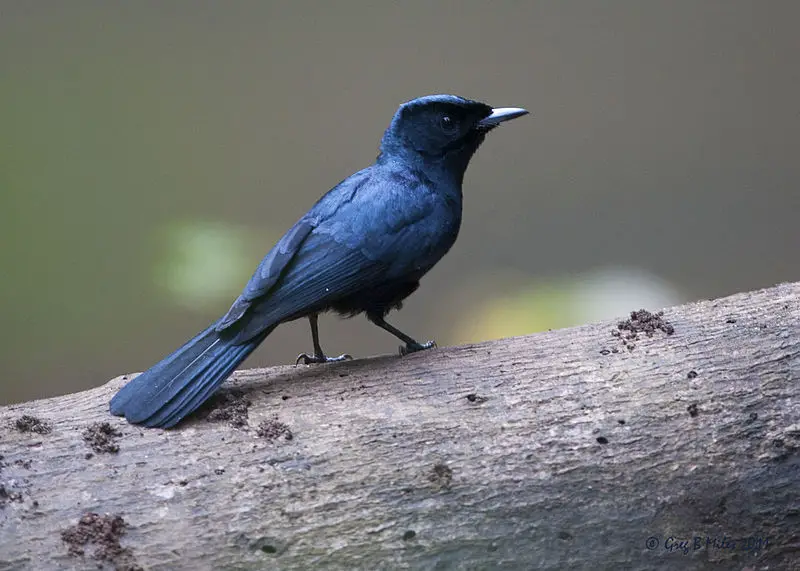
The Shining Flycatcher is a beautiful and slender bird with a long tail and fine bill. This species can be found in northern Australia, as well as in the Moluccas and the Bismarck Archipelago.
They typically inhabit subtropical or tropical moist lowland forests and mangrove forests. The male Shining Flycatcher is entirely glossy blue-black, while the female has a rich chestnut coloration above.
These birds are members of the Monarchidae family of songbirds.
Scientific classification:
| Kingdom | Animalia |
| Phylum | Chordata |
| Class | Aves |
| Order | Passeriformes |
| Family | Monarchidae |
| Genus | Myiagra |
| Species | M. alecto |
Also Featured In: Birds that Live Near Halmahera, Waigeo Island Birds
29. Grey Fantail
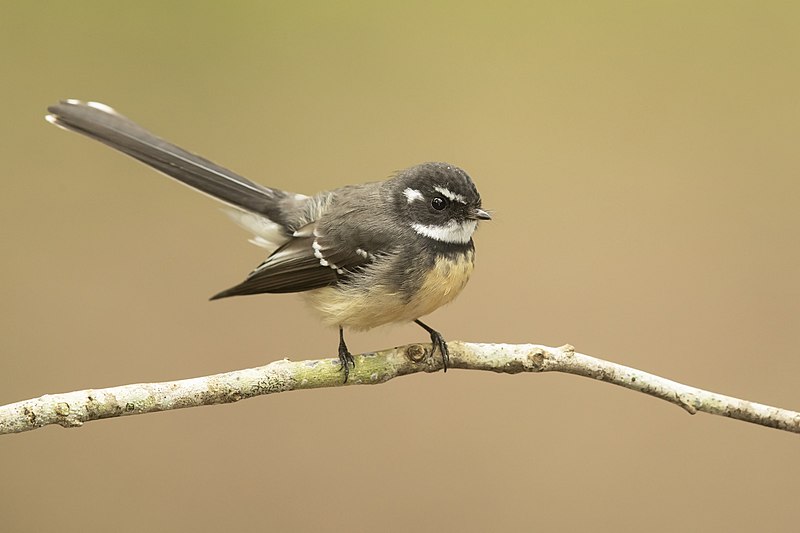
The grey fantail is a tiny bird that primarily eats insects. It has no sexual distinctions, and it may be discovered in Australia, the Solomon Islands, Vanuatu, and New Caledonia.
Although some scientists believe it is the same as the New Zealand fantail for various reasons, including similarities in appearance, others believe it should be classified as a distinct species.
One of the distinguishing features has to do with the bird’s calls. The grey fantail is a prevalent species among bird enthusiasts due to their ability to learn new things and interact with their surroundings.
They are clever birds that enjoy playing and perching on trees. The grey fantail’s habitat comprises woodlands, shrublands, and forests, particularly near bodies of water.
Overall, this species is a delightful addition to any bird lover’s collection.
Scientific classification:
| Kingdom | Animalia |
| Phylum | Chordata |
| Class | Aves |
| Order | Passeriformes |
| Family | Rhipiduridae |
| Genus | Rhipidura |
| Species | R. albiscapa |
Also Featured In: Birds that Live around Victoria, South Australian Birds
30. Striated Thornbill
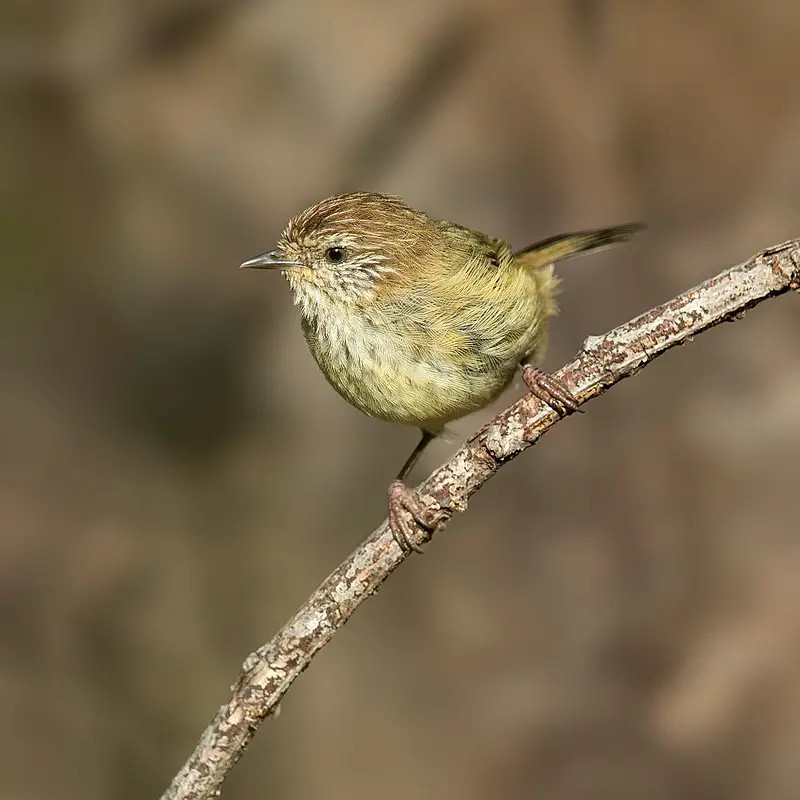
The Striated thornbill is a bird species found only in Australia. Its natural habitat is subtropical or tropical dry forests.
These birds have been given several common names such as striped-crowned thornbill or tit-warbler, and striated tit-warbler or tit.
They are small in size and belong to the family Acanthizidae. John Gould described these birds in 1838 and the scientific name is Acanthiza lineata.
The Striated thornbill has a striped pattern on its head and a sharp bill adapted for feeding on insects. They have a high-pitched and melodious call.
These birds are often seen in pairs or small groups and play an important role in the ecosystem by acting as pollinators and insect controllers. They are a beautiful addition to the biodiversity of Australia.
Scientific classification:
| Kingdom | Animalia |
| Phylum | Chordata |
| Class | Aves |
| Order | Passeriformes |
| Family | Acanthizidae |
| Genus | Acanthiza |
| Species | A. lineata |
31. Eastern Yellow Robin
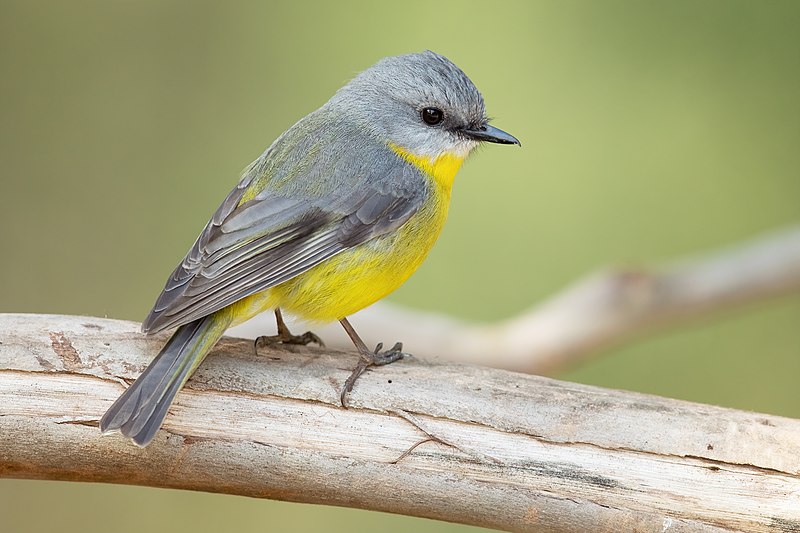
The Eastern yellow robin is a native bird found in coastal and sub-coastal regions of eastern Australia.
With a range extending from South Australia to as far north as Cooktown in Queensland, these birds prefer to live in warm forest areas.
Their bright yellow breast makes them easily recognizable, while their small size and chirpy songs make them a popular sight among birdwatchers.
Eastern yellow robins are known for their friendly nature, often coming very close to humans without fear.
These curious birds are also skilled hunters, preying upon insects and small invertebrates.
In summary, the Eastern yellow robin is a charming bird found in the forests and woodlands of eastern Australia.
Scientific classification:
| Kingdom | Animalia |
| Phylum | Chordata |
| Class | Aves |
| Order | Passeriformes |
| Family | Petroicidae |
| Genus | Eopsaltria |
| Species | E. australis |
Also Featured In: Common Melbourne Birds, Sydney Birds You Need to See
32. Southern Emu-Wren
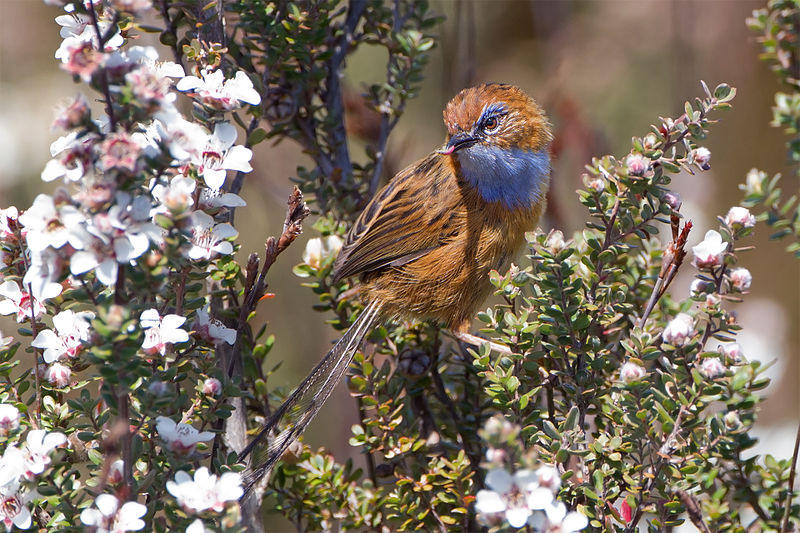
The Southern emu-wren bird is an Australian species found in temperate forests, Mediterranean-type shrubby vegetation, and swamplands.
This small bird belongs to the Maluridae family and is known for its distinctive appearance.
The male has rusty-brown upper parts with streaks of black and a reddish crown. Its wings are grey-brown, and its throat, upper chest, and eyes are a beautiful sky-blue.
However, this stunning bird is unfortunately considered to be a vulnerable species due to habitat loss and degradation caused by human activities.
Conservation efforts are underway to protect the Southern emu-wren and ensure its survival for future generations to enjoy.
Scientific classification:
| Kingdom | Animalia |
| Phylum | Chordata |
| Class | Aves |
| Order | Passeriformes |
| Family | Maluridae |
| Genus | Stipiturus |
| Species | S. malachurus |
33. Red-Backed Fairywren
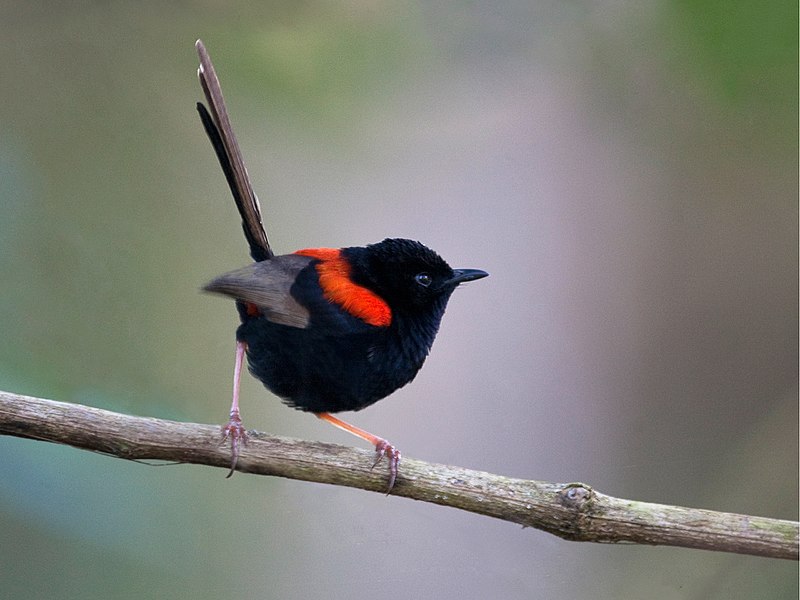
The Red-backed fairywren is a bird found in Australia. It can be seen near rivers and coastal areas along the northern and eastern coastlines. The male bird has black head, upperparts and tail during the breeding season.
The Red-backed fairywren belongs to the Australasian wren family, Maluridae. It is a passerine bird and is endemic to Australia. Females and juveniles have a brownish plumage with a reddish-brown back.
The Red-backed fairywren is a relatively small bird with a length of 12-14 cm.
They are known for their energetic movements and playful behavior. Their diet consists of insects and small spiders which they catch by chasing and hopping along the ground.
The conservation status of this bird is Least Concern.
Scientific classification:
| Kingdom | Animalia |
| Phylum | Chordata |
| Class | Aves |
| Order | Passeriformes |
| Family | Maluridae |
| Genus | Malurus |
| Species | M. melanocephalus |
34. Brown Honeyeater
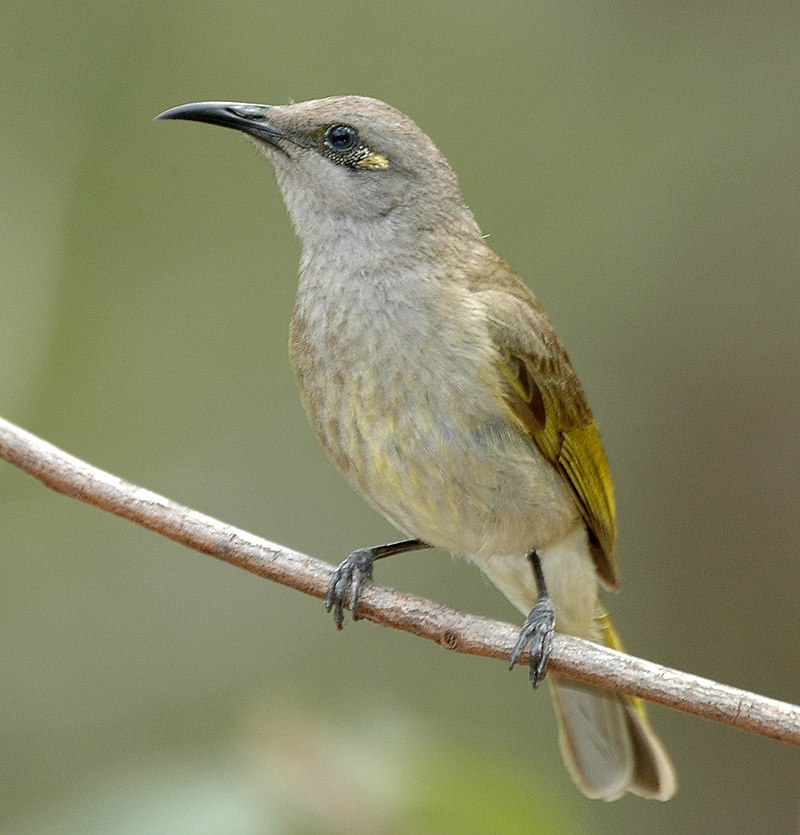
The brown honeyeater is a bird species belonging to the Meliphagidae family. With their brush-tipped tongues, they are adapted for nectar feeding. Honeyeaters are found mainly in Australia, New Guinea, and parts of Indonesia.
However, the brown honeyeater is unique in that it is also found on the island of Bali, making it the only honeyeater species to occur there.
The bird has brown plumage, which helps it to blend in with its surroundings, enabling it to evade detection by predators.
Brown honeyeaters feed on insects and nectar found in the flowers of various plant species. The species is known for its melodious calls and is a common sight in gardens, parks, and open woodlands.
Despite being widespread, the brown honeyeater is not considered endangered.
Scientific classification:
| Kingdom | Animalia |
| Phylum | Chordata |
| Class | Aves |
| Order | Passeriformes |
| Family | Meliphagidae |
| Genus | Lichmera |
| Species | L. indistincta |
Also Featured In: Most Common Western Australia Birds, Common Birds of Lombok
35. Rufous Whistler
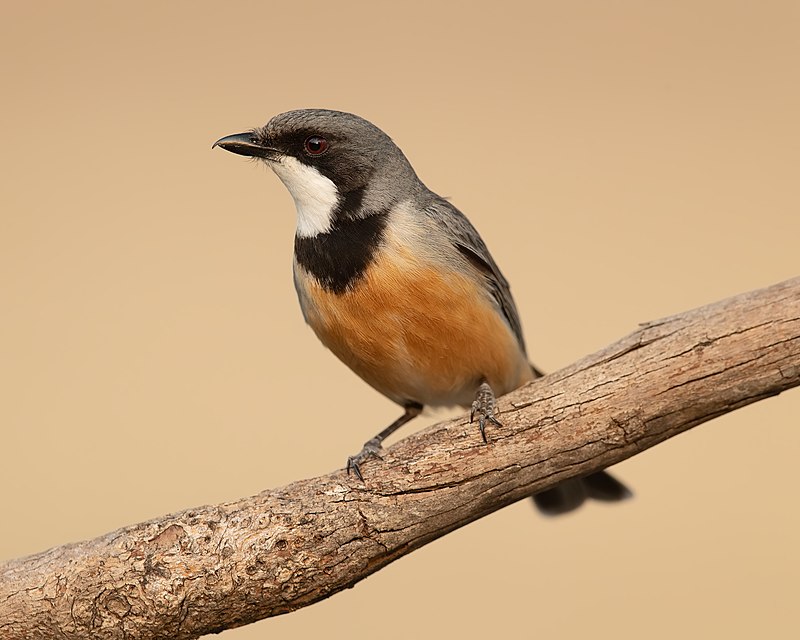
The Rufous whistler has reddish-brown and grey feathers that are not particularly flashy. However, it more than makes up for its subdued appearance with its impressive singing ability.
This bird species can be found in New Caledonia and Australia, where it is known for its variety of melodies and calls.
The Rufous whistler is a member of the Pachycephalidae family, which is known for its many musical calls.
It was initially classified in the Sylvia genus by the English ornithologist J.
Overall, the Rufous whistler is not the most visually striking bird, but its beautiful songs and calls make it a favorite among birdwatchers and nature enthusiasts.
Scientific classification:
| Kingdom | Animalia |
| Phylum | Chordata |
| Class | Aves |
| Order | Passeriformes |
| Family | Pachycephalidae |
| Genus | Pachycephala |
| Species | P. rufiventris |
Also Featured In: Birds that You’ll find in Perth, Birds of New Caledonia
36. White-Cheeked Honeyeater
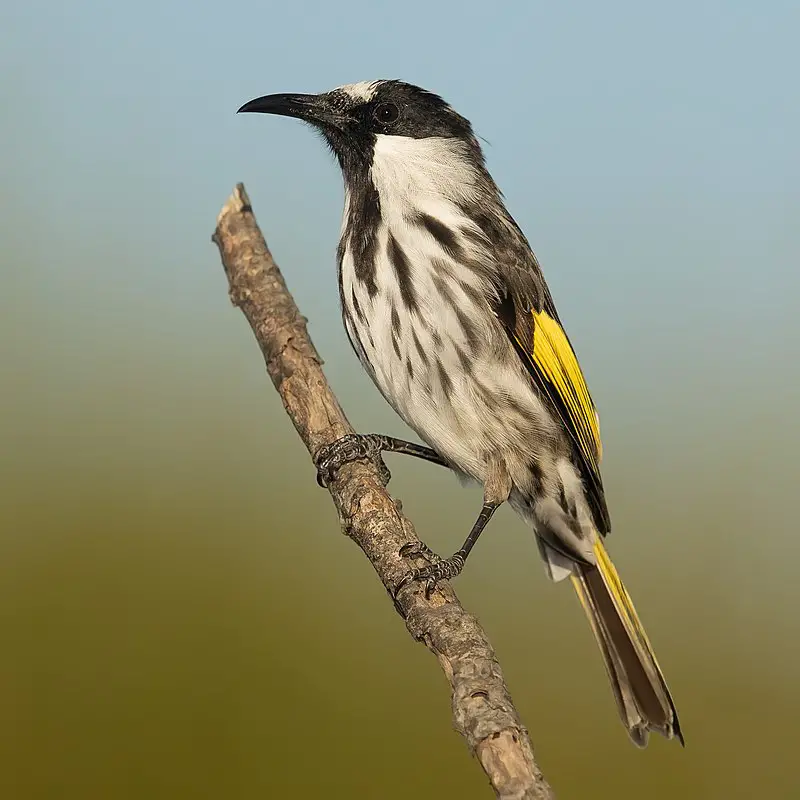
The White-cheeked honeyeater is a bird native to both the east coast and southwest corner of Australia. It is easily identifiable by its large white patch on the cheek, brown eyes, and yellow panel on its wing.
The bird was first described by Bechstein in 1811 and has two recognized subspecies: Phylidonyris niger niger in eastern Australia and P. n. gouldii in the southwestern corner of Western Australia.
These birds can often be seen flitting through the trees and shrubs in search of nectar, insects, and spiders to fuel their energetic lifestyles.
Their unique appearance and active behavior make them a favorite among bird watchers and nature enthusiasts alike.
Scientific classification:
| Kingdom | Animalia |
| Phylum | Chordata |
| Class | Aves |
| Order | Passeriformes |
| Family | Meliphagidae |
| Genus | Phylidonyris |
| Species | P. niger |
37. Large-Billed Scrubwren
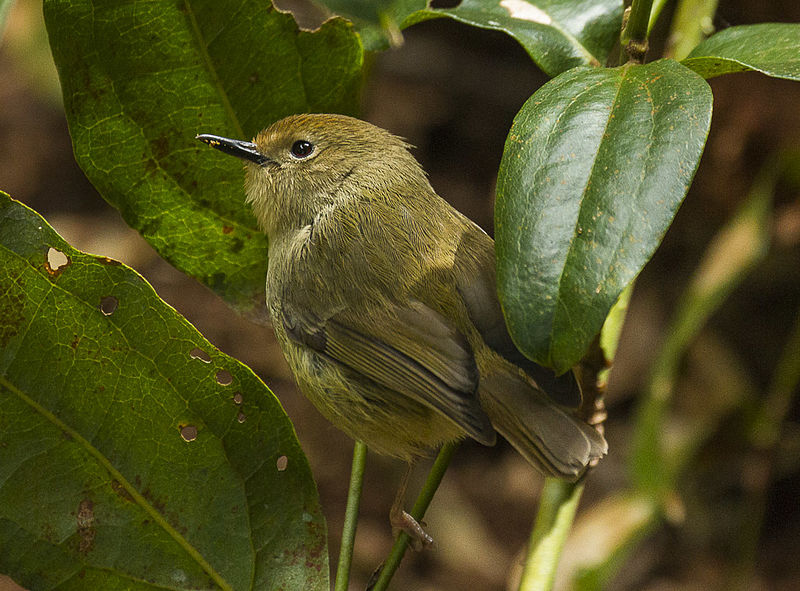
The Large-billed scrubwren is a passerine bird found in eastern Australia. It inhabits denser undergrowth in various types of forests. This bird was first described by John Gould in 1838.
The generic name Sericornis was given due to its unique bill shape. Despite its name, it is a small bird with a length of only 10 cm.
Its plumage is brown and reddish-brown with a distinctive light brown streak on its face.
The Large-billed scrubwren is known for its distinct and varied song, which can be heard throughout its range.
This species feeds on insects and spiders which are gleaned from the forest understory. Due to its specific habitat requirements, it is considered vulnerable to habitat loss and fragmentation.
Scientific classification:
| Kingdom | Animalia |
| Phylum | Chordata |
| Class | Aves |
| Order | Passeriformes |
| Family | Acanthizidae |
| Genus | Sericornis |
| Species | S. magnirostra |
38. White-Throated Honeyeater
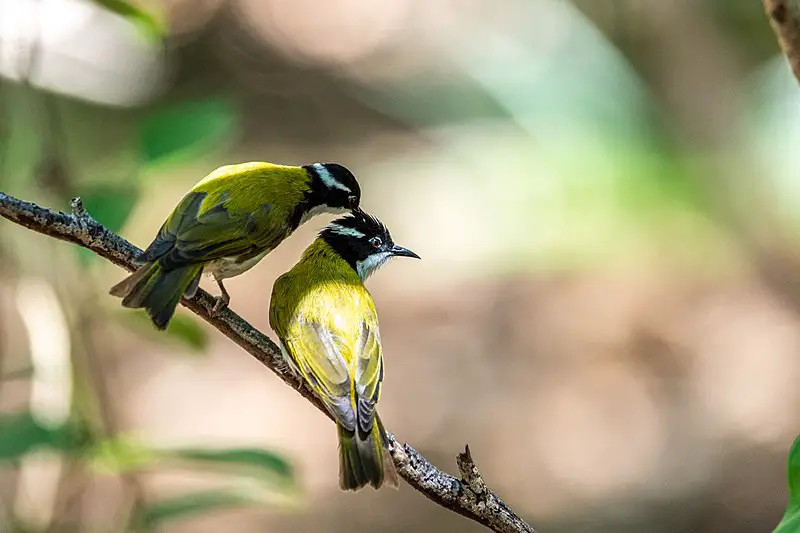
The White-throated honeyeater bird primarily inhabits regions of New Guinea, eastern and northern Australia. It belongs to the Meliphagidae family and measures around 11.5 to 14.5 cm in length.
The bird has olive-green feathers on the upper side, and white plumage beneath, with a black head. An additional pale blue or white feature lies over the eyes, with a small white stripe across the nape.
The bird displays a distinct melodic tweeting sound to attract mates or indicate their presence. The White-throated honeyeater was identified by John Gould in 1848. The bird feeds on nectar from flowers, insects, and small fruits.
Urbanization causes no significant reduction in their population as they have adapted well to it.
Scientific classification:
| Kingdom | Animalia |
| Phylum | Chordata |
| Class | Aves |
| Order | Passeriformes |
| Family | Meliphagidae |
| Genus | Melithreptus |
| Species | M. albogularis |
39. Spectacled Monarch
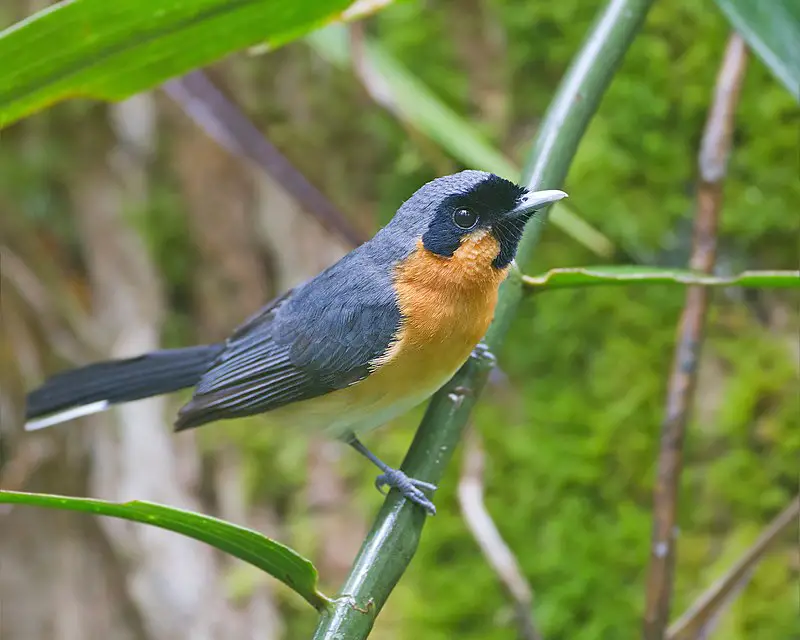
The Spectacled monarch is a bird species belonging to the Monarchidae family. It is native to various regions, including Australia, Indonesia, and Papua New Guinea.
The bird inhabits subtropical or tropical forest environments, including lowland and montane forests, as well as mangrove forests.
The species was initially classified under the Drymophila genus but was eventually moved to Symposiachrus Trivirgatus.
The Spectacled monarch bird is known for its unique appearance, which features a distinctive pattern around its eyes, resembling a pair of spectacles.
Although the species is not under any significant threat, conservation efforts are still necessary to protect its natural habitats and ensure its sustainability.
Overall, the Spectacled monarch is an essential part of the diverse bird species inhabiting the forests of its range.
Scientific classification:
| Kingdom | Animalia |
| Phylum | Chordata |
| Class | Aves |
| Order | Passeriformes |
| Family | Monarchidae |
| Genus | Symposiachrus |
| Species | S. trivirgatus |
Also Featured In: Birds in Sumba,
40. Australian Golden Whistler
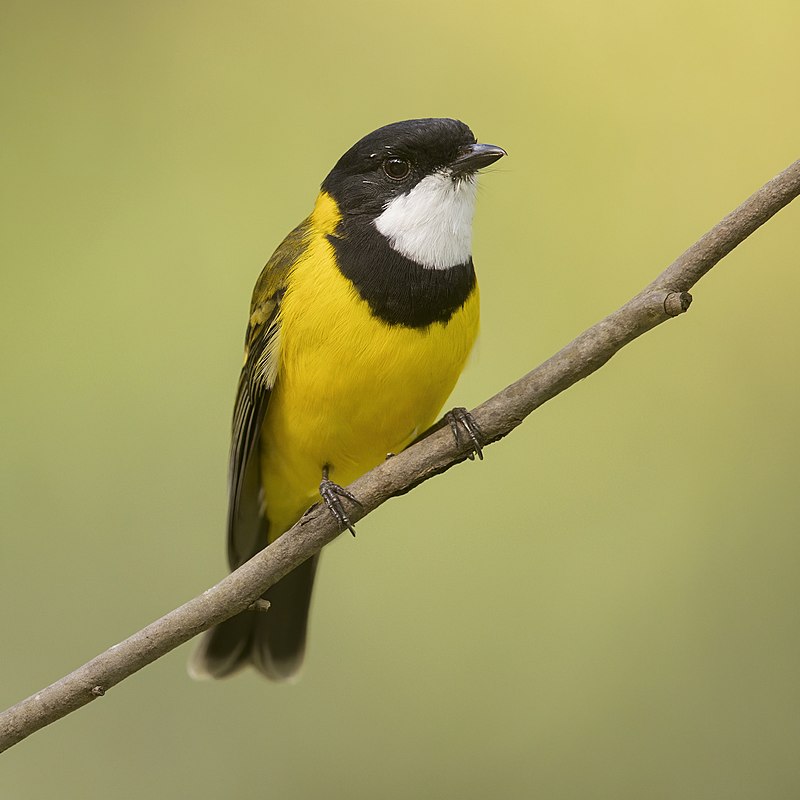
The Australian golden whistler, also known as golden whistler, is a bird species found in various Australian habitats but not in the interior and most part of the north.
They inhabit forest, woodland, mallee, mangrove, and scrub and are mostly residents, but populations in southeastern Australia migrate northwards during winter.
The taxonomy of the Australian golden whistler bird is subject to dispute due to its complex nature.
This beautiful bird has a golden-yellow plumage with a black mask around its eyes, distinctive white eyebrows and throat, and wings and tail with black and white markings.
It is known for its sweet and melodic whistling calls, often heard during breeding season.
Australian golden whistlers mainly feed on insects and fruits, and can be observed foraging in trees and shrubs.
They play an important role in maintaining the ecosystem and are a source of delight for birdwatchers and nature lovers.
Scientific classification:
| Kingdom | Animalia |
| Phylum | Chordata |
| Class | Aves |
| Order | Passeriformes |
| Family | Pachycephalidae |
| Genus | Pachycephala |
| Species | P. pectoralis |
Also Featured In: Common Flinders Island Birds,
41. Paradise Riflebird
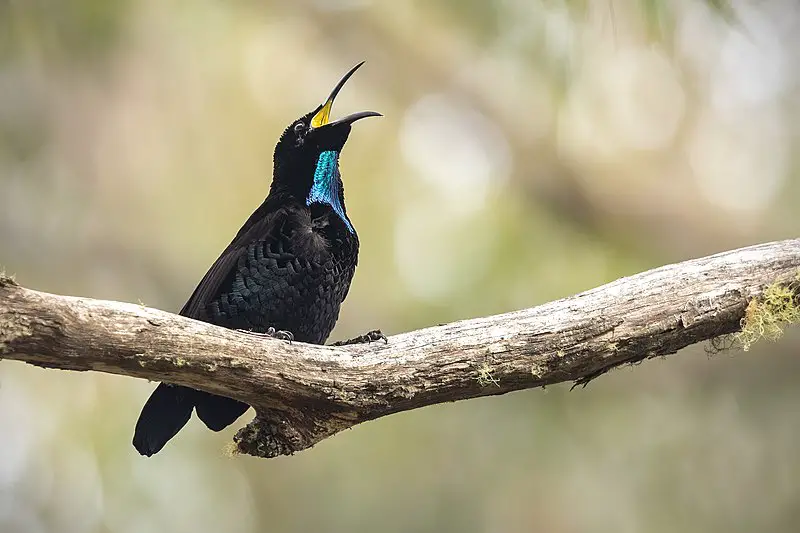
The Paradise riflebird is a stunning passerine bird found in the rainforests of eastern Australia. Belonging to the Paradisaeidae family and the Ptiloris genus, it is one of four species.
The male bird boasts a black body with iridescent blue-green patches, making it look glorious. The female, on the other hand, is gray-brown and white, contrasting with the male bird’s appearance.
This species is sexually dimorphic. Being a frugivorous bird, the Paradise riflebird mostly feeds on fruits. It prefers subtropical and temperate rainforests as its habitat.
This bird adds to the fascination of the eastern Australian rainforests with its beauty and ecological significance.
Scientific classification:
| Kingdom | Animalia |
| Phylum | Chordata |
| Class | Aves |
| Order | Passeriformes |
| Family | Paradisaeidae |
| Genus | Ptiloris |
| Species | P. paradisea |
Also Featured In: Beautiful Birds Found in Paradise Island,
42. Beach Stone-Curlew
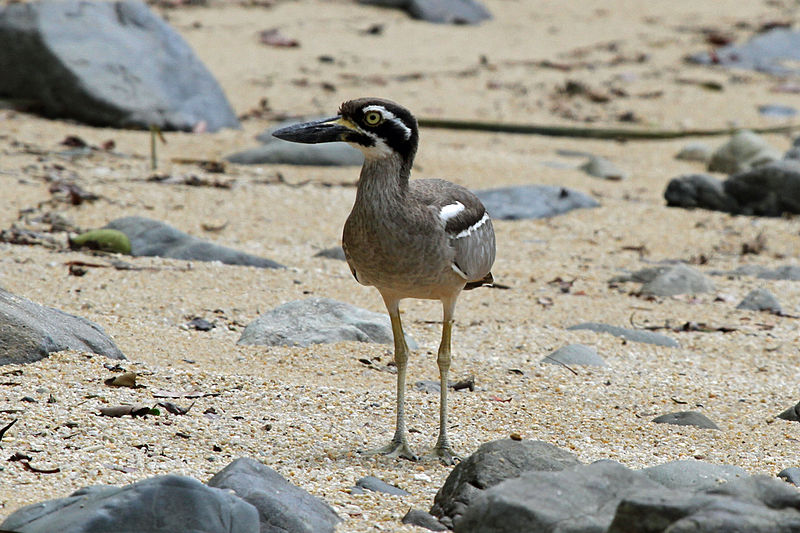
The beach stone-curlew is a large ground-dwelling bird found in Australasia and Southeast Asia. Weighing up to 1 kg, it is one of the largest shorebirds in the world.
With a distinct appearance, this bird has a sturdy body and long legs, making it well-suited for hunting on the beach.
The male species typically weighs a mean of 1,032 g, while the female species weighs around 1,000 g.
Its size and weight make it the heaviest living member of the Charadriiformes family outside of gulls.
The beach stone-curlew is also known as the beach thick-knee, owing to the distinctive thick joint on its leg.
This bird has become vulnerable to habitat loss and hunting, and conservation efforts have been initiated to protect the species.
Scientific classification:
| Kingdom | Animalia |
| Phylum | Chordata |
| Class | Aves |
| Order | Charadriiformes |
| Family | Burhinidae |
| Genus | Esacus |
| Species | E. magnirostris |
43. Black-Breasted Buttonquail
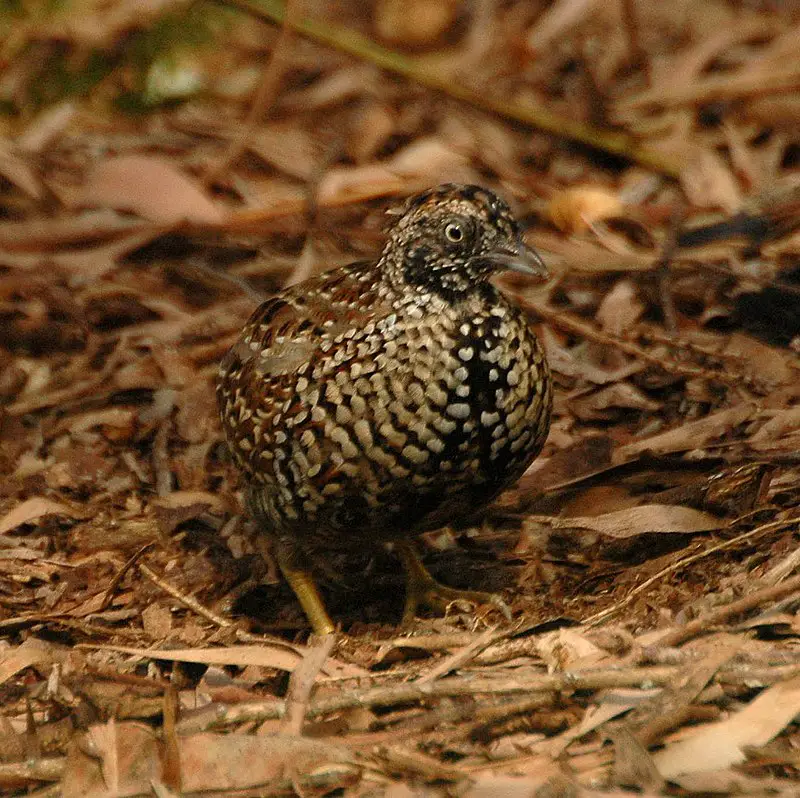
The Black-breasted buttonquail is a unique bird species that can be found in certain parts of eastern Australia. Despite its name, it is not related to true quails.
This plump bird has a distinct quail-like shape and measures around 17–19 cm in length. Its plumage is predominantly marbled black, rufous, and pale brown, and it features prominent white spots and stripes.
Interestingly, it also has white eyes which add to its distinctive appearance. Due to its rarity, the Black-breasted buttonquail is considered an endangered species.
Efforts are being made to protect this bird, especially since its natural habitat has been affected by human activities such as agriculture and land development.
Scientific classification:
| Kingdom | Animalia |
| Phylum | Chordata |
| Class | Aves |
| Order | Charadriiformes |
| Family | Turnicidae |
| Genus | Turnix |
| Species | T. melanogaster |
44. Lewin’s Honeyeater
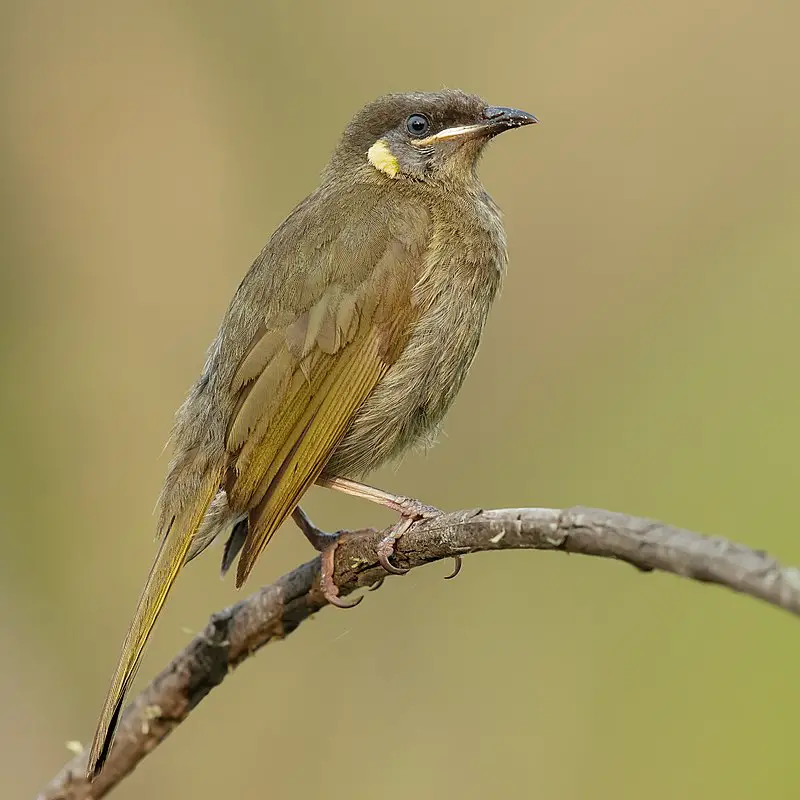
Lewin’s honeyeater is a bird found in the ranges along the east coast of Australia. It is named after the Australian artist John Lewin.
This small to medium-sized bird measures about 20-22 cm in length and has a semicircular ear-patch that is pale yellow in color.
The bird is characterized by its dark greenish-grey plumage and creamy yellow gape. It is known to inhabit a variety of habitats, including forests, woodlands, and shrublands.
Lewin’s honeyeater feeds on nectar from flowers and insects. The bird’s unique appearance and behavior make it a popular subject among bird enthusiasts and nature lovers alike.
Scientific classification:
| Kingdom | Animalia |
| Phylum | Chordata |
| Class | Aves |
| Order | Passeriformes |
| Family | Meliphagidae |
| Genus | Meliphaga |
| Species | M. lewinii |
45. Lewin’s Rail
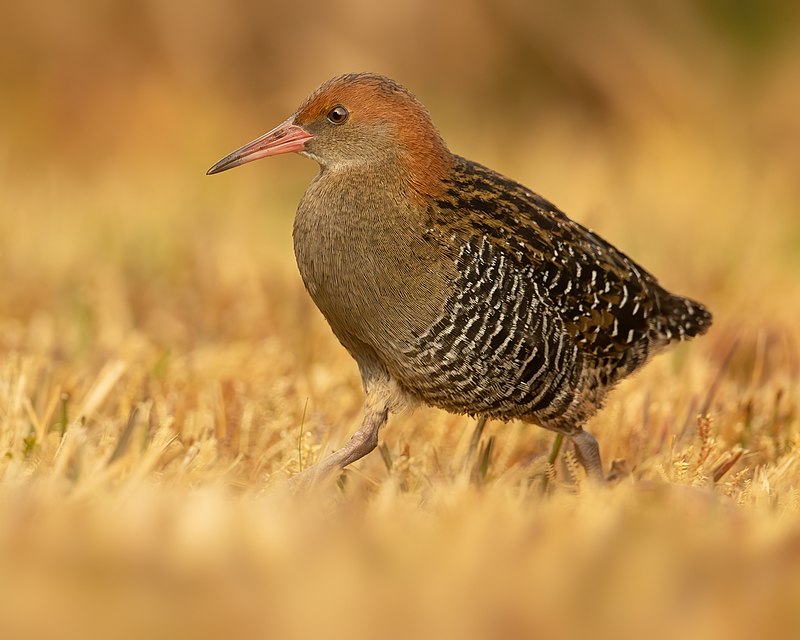
Lewin’s rail is a bird species from the Rail family, also known as water rail, Lewin’s water rail, slate-breasted rail and short-toed water rail. It is found in Australia and is identified by its slate-colored breast.
The bird is named after English naturalist and illustrator William Lewin. Lewin’s rail is a small bird with a secretive nature and prefers to stay near wetlands and marshes with dense vegetation for protection. It is an omnivorous bird, feeding on insects, snails, small fish and seeds.
Due to habitat loss and predation by feral animals, the population of Lewin’s rail has decreased, and it is now considered a threatened species. Conservation efforts are being made to protect the remaining habitats of this bird.
Scientific classification:
| Kingdom | Animalia |
| Phylum | Chordata |
| Class | Aves |
| Order | Gruiformes |
| Family | Rallidae |
| Genus | Lewinia |
| Species | L. pectoralis |
46. Leaden Flycatcher
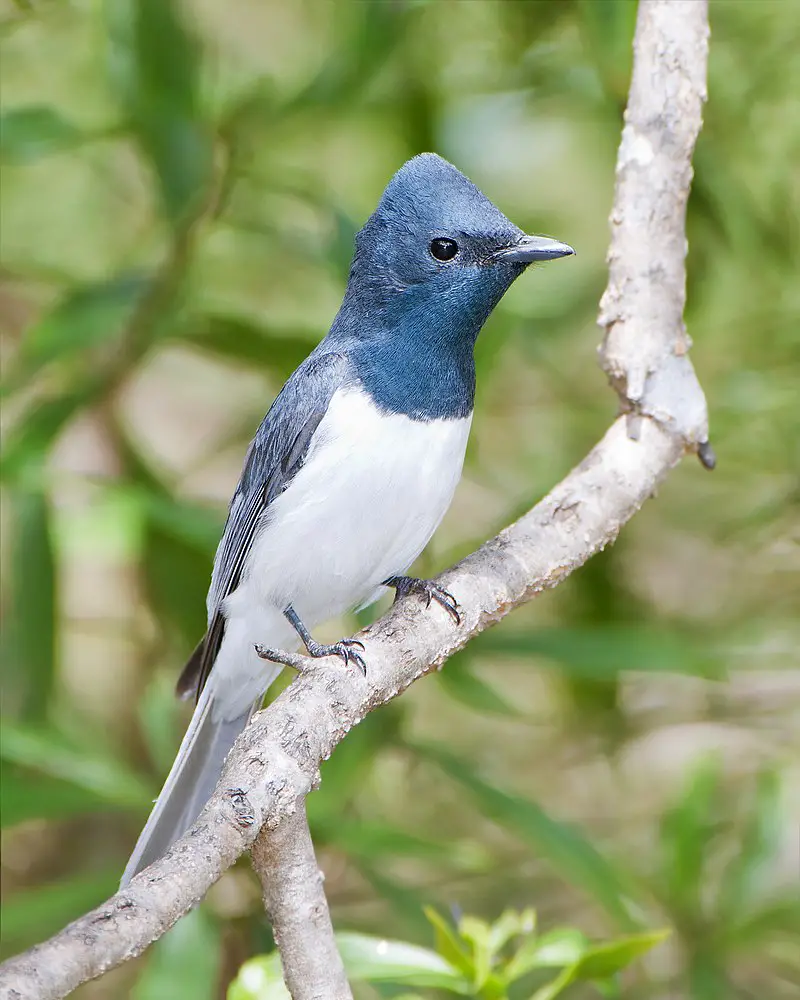
The leaden flycatcher is a bird species that belongs to the Monarchidae family. Males of this species are lustrous azure with white underparts, while females have a leaden head, mantle, and back, along with rufous throat and breast.
They typically measure around 15 cm in length. Found mainly in eastern and northern Australia, Indonesia, and Papua New Guinea, these birds prefer subtropical or tropical mangroves as their natural habitat.
They are known for their distinctive fly-catching behavior, where they prey on insects in mid-air.
The leaden flycatcher is a skilled hunter and is known for its agility and accuracy when catching insects.
These birds are also known for their melodious songs, which can be heard in their natural habitats. They are a valued part of the ecosystem and are fascinating to observe.
Scientific classification:
| Kingdom | Animalia |
| Phylum | Chordata |
| Class | Aves |
| Order | Passeriformes |
| Family | Monarchidae |
| Genus | Myiagra |
| Species | M. rubecula |
47. Australian Logrunner
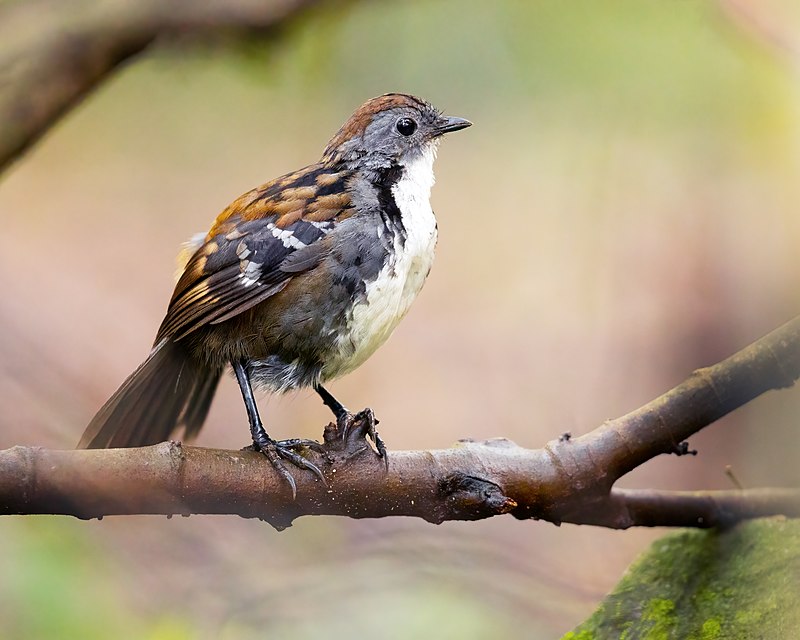
The Australian logrunner is a bird found only in eastern Australia. This bird has adapted unique foraging techniques in searching for its food.
It thrives in the floors of forests in southeastern Australia, including the temperate, subtropical, and tropical moist lowland forests.
This bird is not related to the logrunner found in New Guinea. Before 2002, it was thought to be one and the same with the New Guinea logrunner.
The Australian logrunner is a fascinating bird that has adapted to its environment and has become incredibly skilled at finding food in its habitat.
Scientific classification:
| Kingdom | Animalia |
| Phylum | Chordata |
| Class | Aves |
| Order | Passeriformes |
| Family | Orthonychidae |
| Genus | Orthonyx |
| Species | O. temminckii |
48. Pale-Yellow Robin
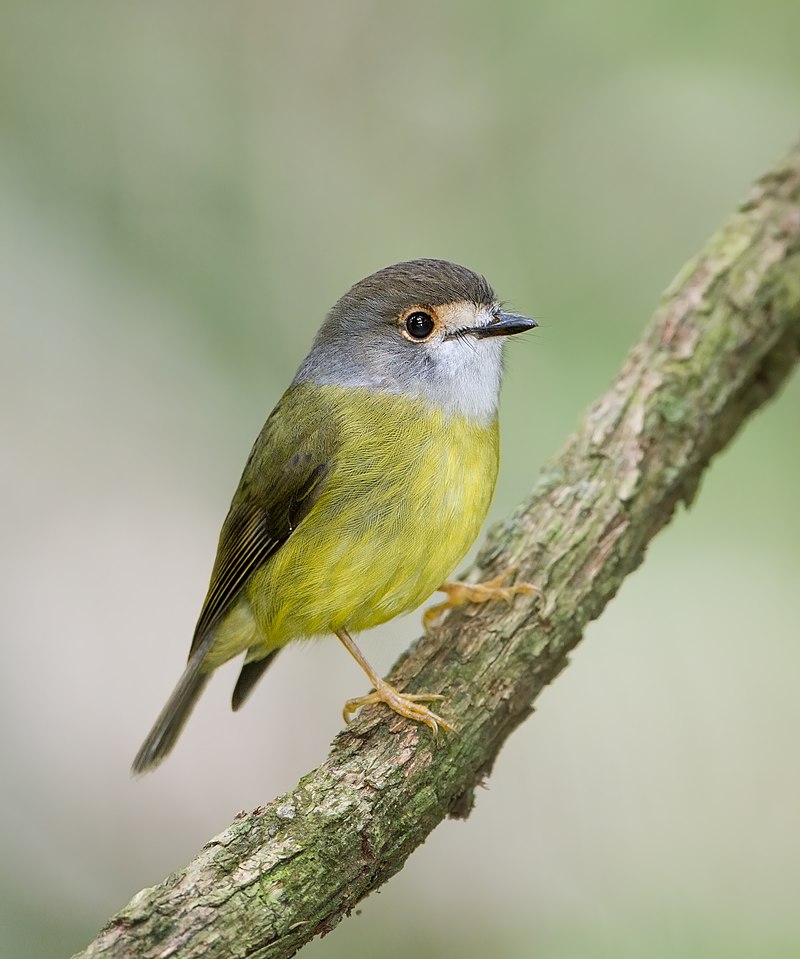
The Pale-yellow robin is a species of passerine bird found only in eastern Australia. It lives in moist lowland forests and has a grey head with olive upperparts and yellow underparts.
Both male and female have similar appearance. It is a nondescript bird with white throat. The bird is small and comes in two subspecies, with the smaller one known as nana found in North Queensland.
Scientific classification:
| Kingdom | Animalia |
| Phylum | Chordata |
| Class | Aves |
| Order | Passeriformes |
| Family | Petroicidae |
| Genus | Tregellasia |
| Species | T. capito |
Also Featured In: Birds of Far North Queensland,
49. Superb Fruit Dove
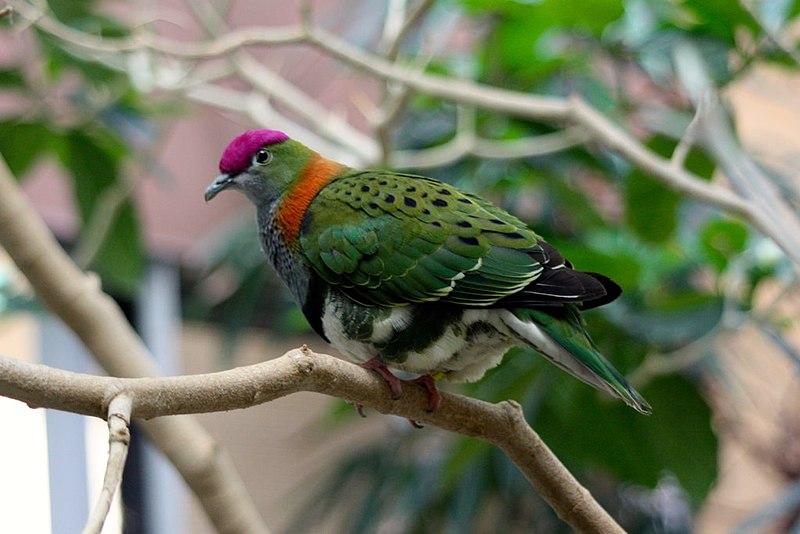
The Superb fruit dove, also called the Purple-crowned fruit dove, is a beautiful bird belonging to the Columbidae family. It is medium-sized and measures around 22-24 cm long.
Its vibrant colors make it an attractive-looking bird. Male doves are sexually dimorphic, displaying bright orange nape, green ears, and a purple crown. The grey breast distinguishes it from the abdomen, which is also its color.
Superb fruit doves are mostly found in forests, gardens, and plantations. They mainly feed on fruits, and their small beaks allow them to feed on small berries and fruits.
These birds have a gentle and soft cooing sound, mainly used to communicate with their mates.
The Superb fruit dove is native to Indonesia, Papua New Guinea, and the Solomon Islands. It is a popular bird among bird-watchers due to its colorful appearance and unique behaviors.
Scientific classification:
| Kingdom | Animalia |
| Phylum | Chordata |
| Class | Aves |
| Order | Columbiformes |
| Family | Columbidae |
| Genus | Ptilinopus |
| Species | P. superbus |
50. Black-Faced Monarch
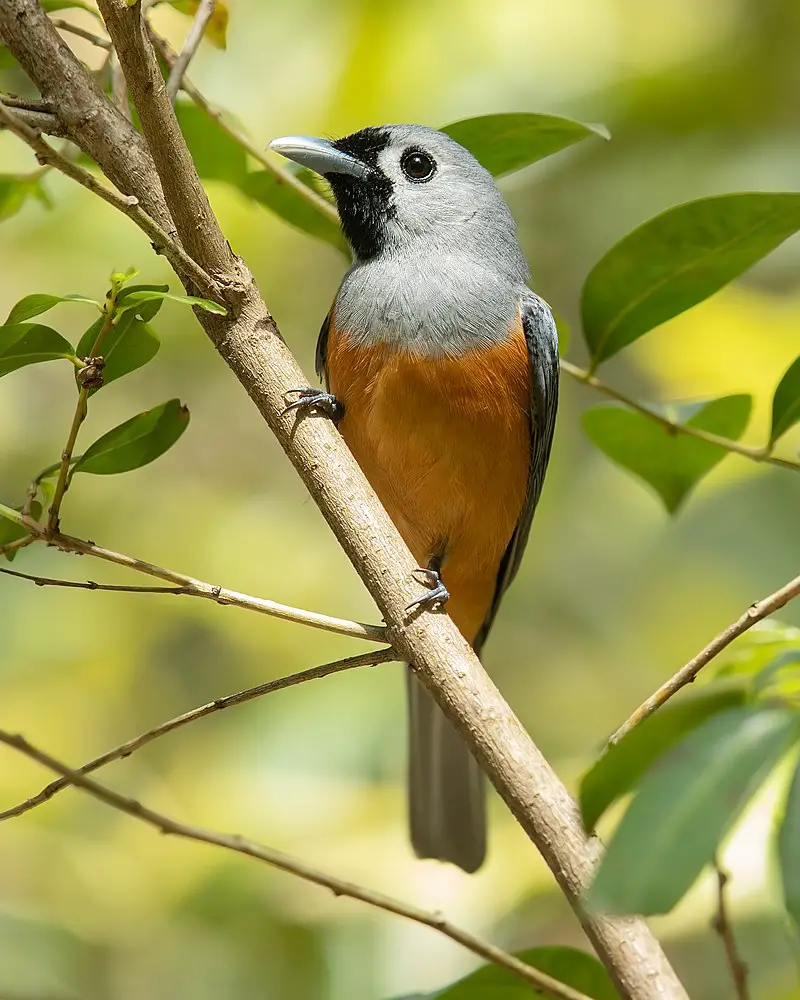
The black-faced monarch is a passerine bird found along the eastern coast of Australia and in New Guinea.
It belongs to the family Monarchidae and is known for its beautiful black and white coloration with a distinctive black face.
During the austral winter, most birds migrate to New Guinea. The species was first described in 1818 as Muscicapa melanopsis by Louis Vieillot.
The bird is known for its melodious song and can often be heard singing in its habitat of rainforests, woodlands, and coastal scrubs.
Its diet consists of insects, spiders, and other small invertebrates, which it catches by agilely flitting from branch to branch.
The black-faced monarch is an important species in its ecosystem, helping to control insect populations and playing a key role in the food chain.
Scientific classification:
| Kingdom | Animalia |
| Phylum | Chordata |
| Class | Aves |
| Order | Passeriformes |
| Family | Monarchidae |
| Genus | Monarcha |
| Species | M. melanopsis |
51. Yellow-Throated Scrubwren
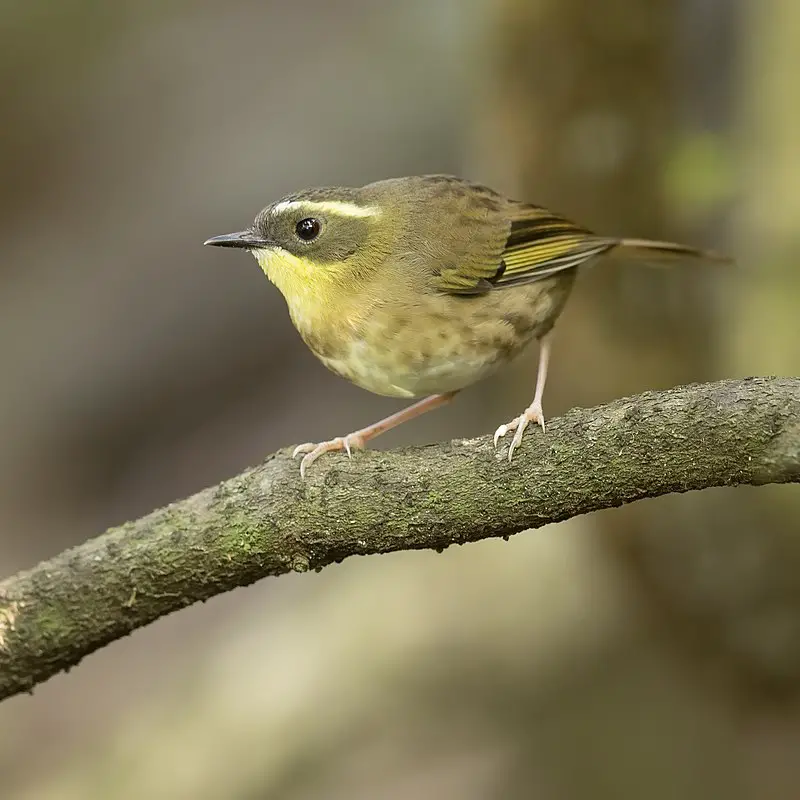
The Yellow-throated scrubwren is a tiny bird found in parts of eastern coastal Australia. It typically lives in wet forests and rainforests and feeds mainly on insects.
This ground-dwelling bird has a striking yellow throat and is a member of the Acanthizidae family.
It was previously classified in the Sericornis genus but is now the sole species in the Neosericornis genus.
Despite its small size, this bird is a keen survivor with an excellent adaptation for living in the wild.
Scientific classification:
| Kingdom | Animalia |
| Phylum | Chordata |
| Class | Aves |
| Order | Passeriformes |
| Family | Acanthizidae |
| Genus | Neosericornis Mathews, 1912 |
| Species | N. citreogularis |